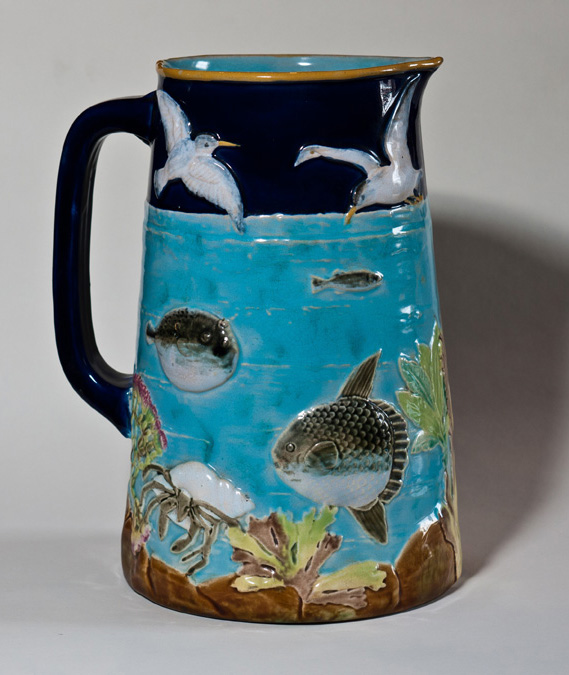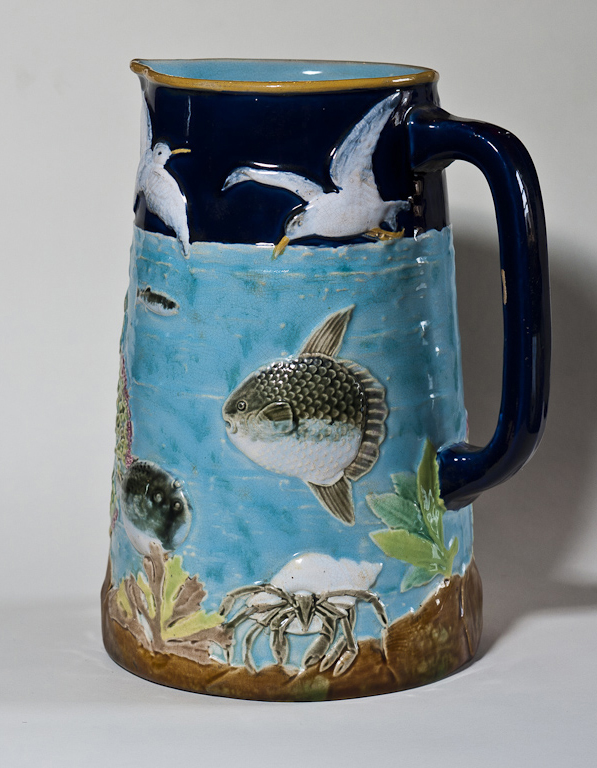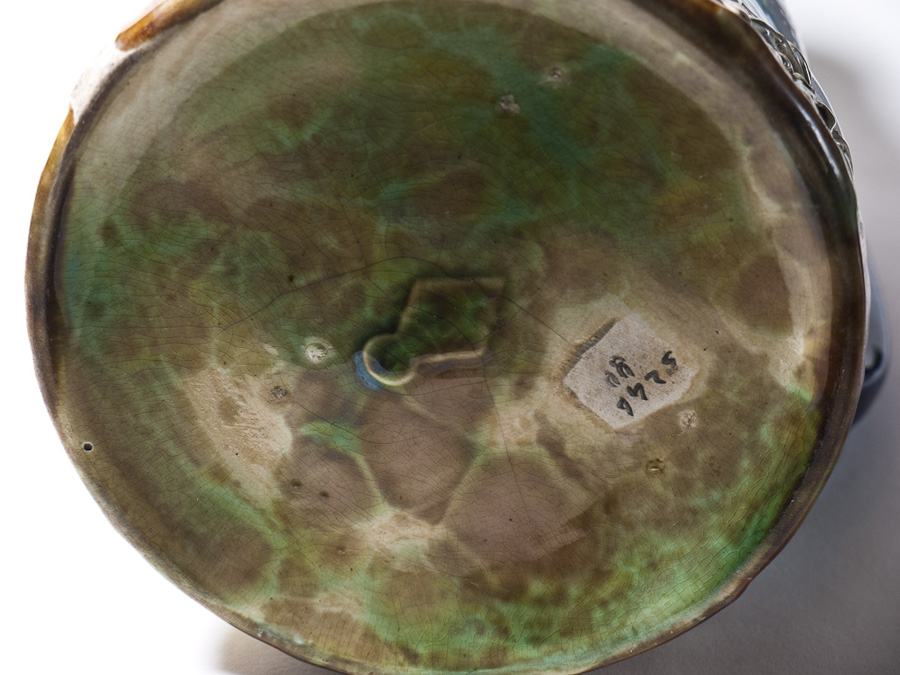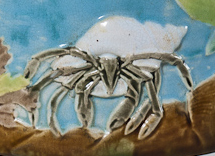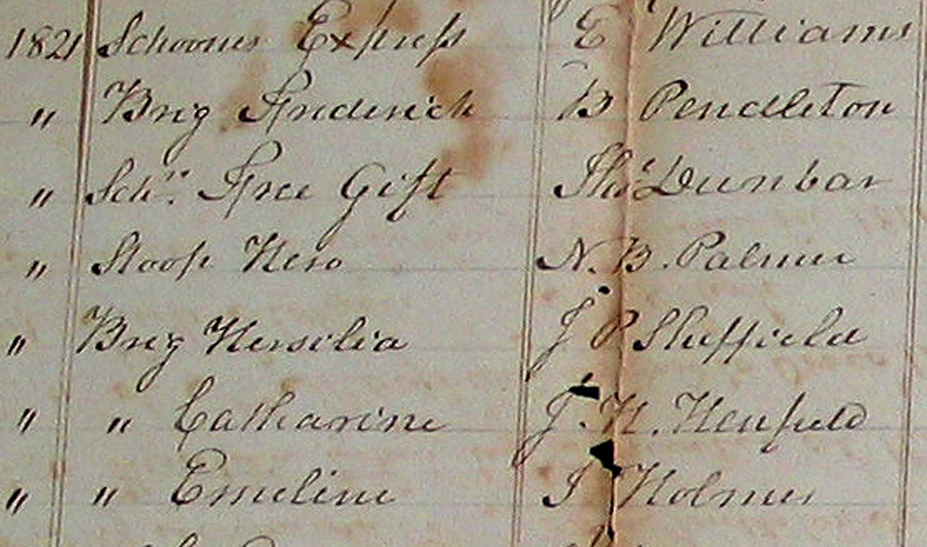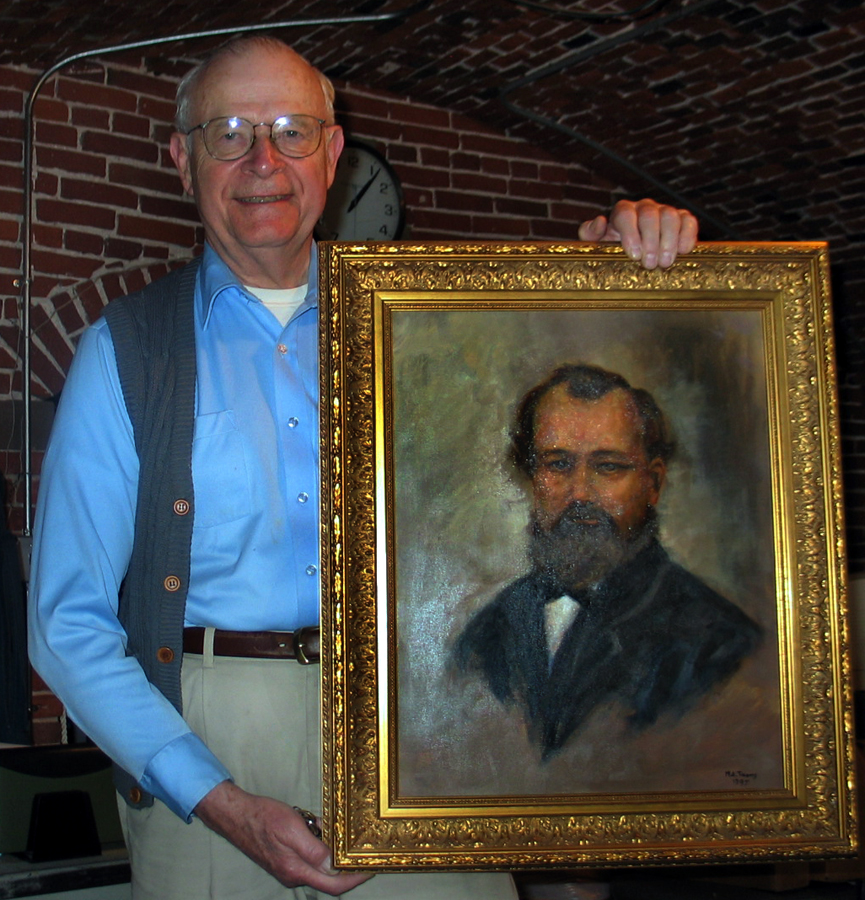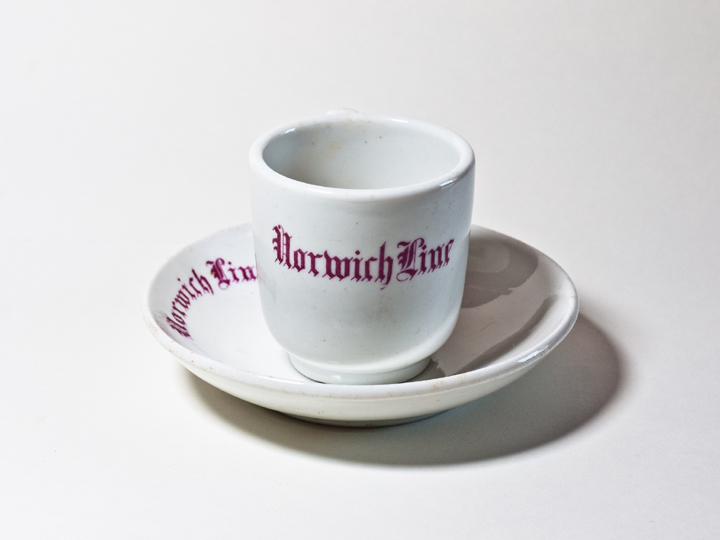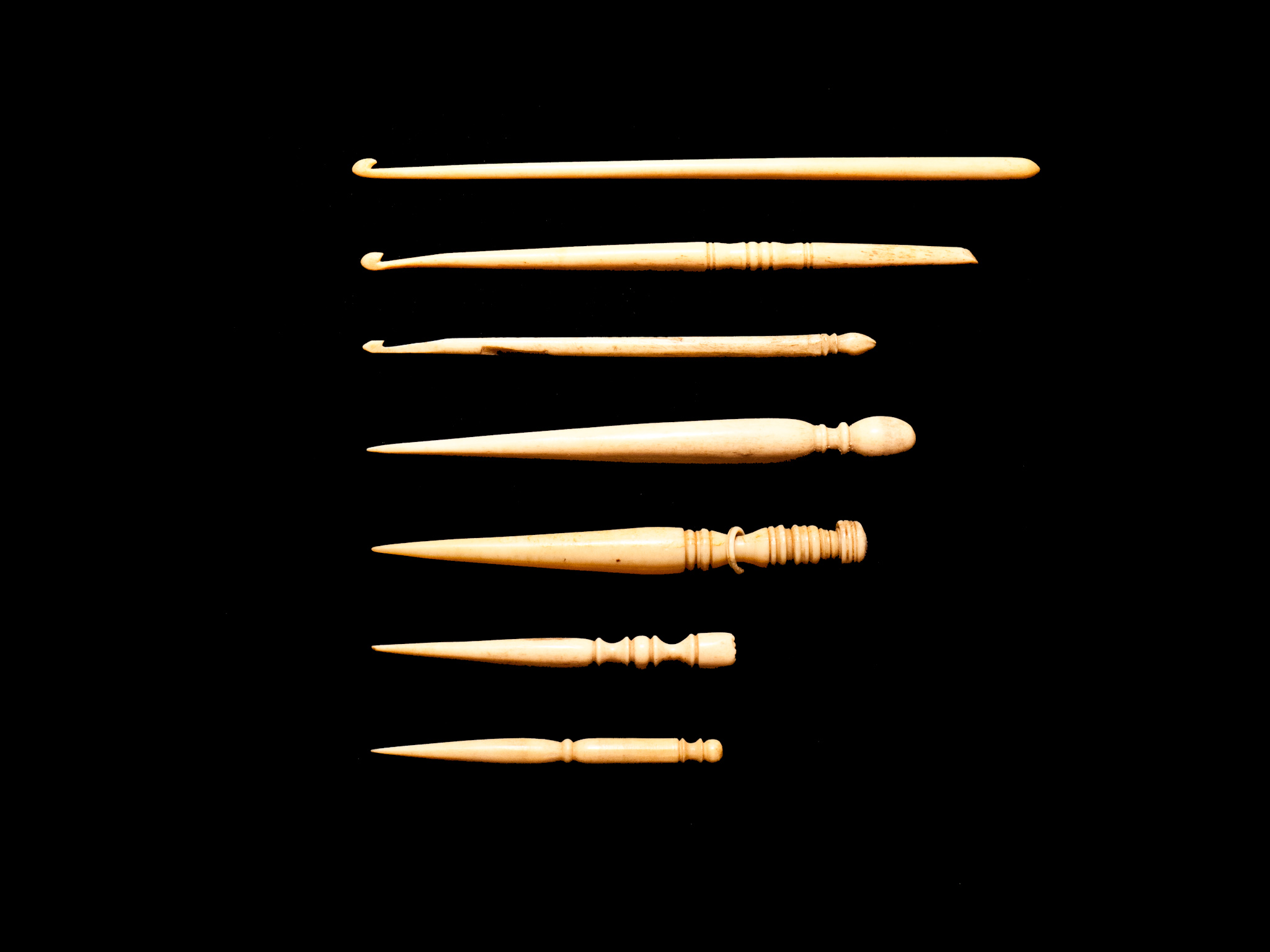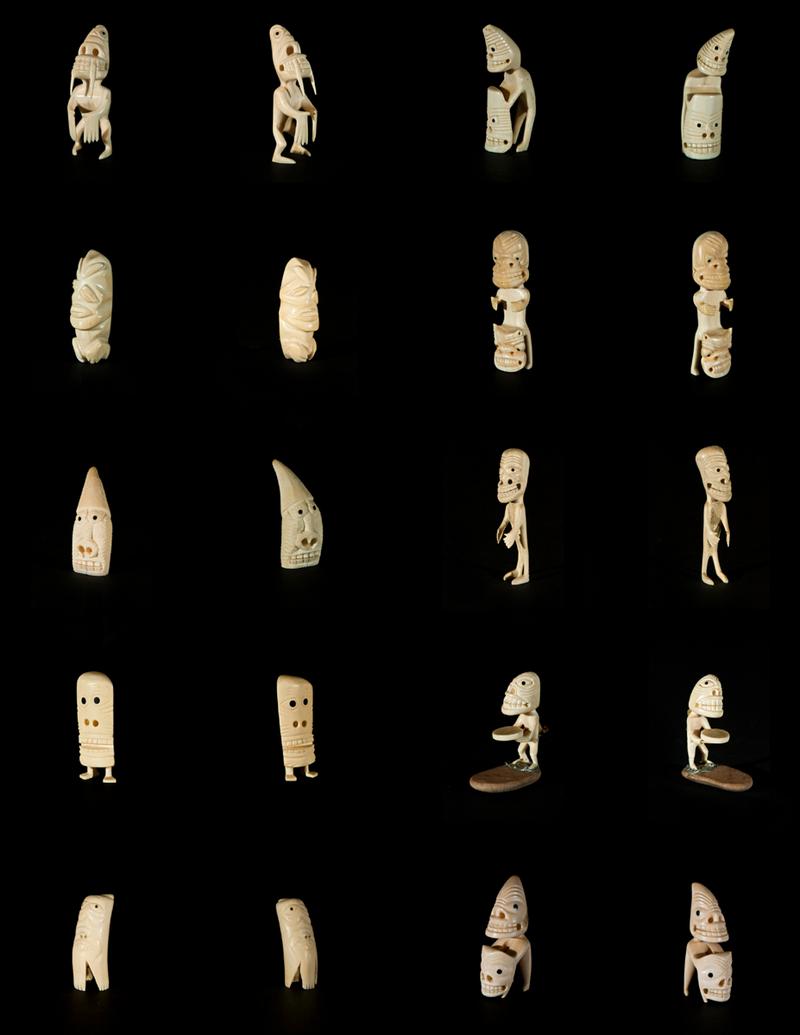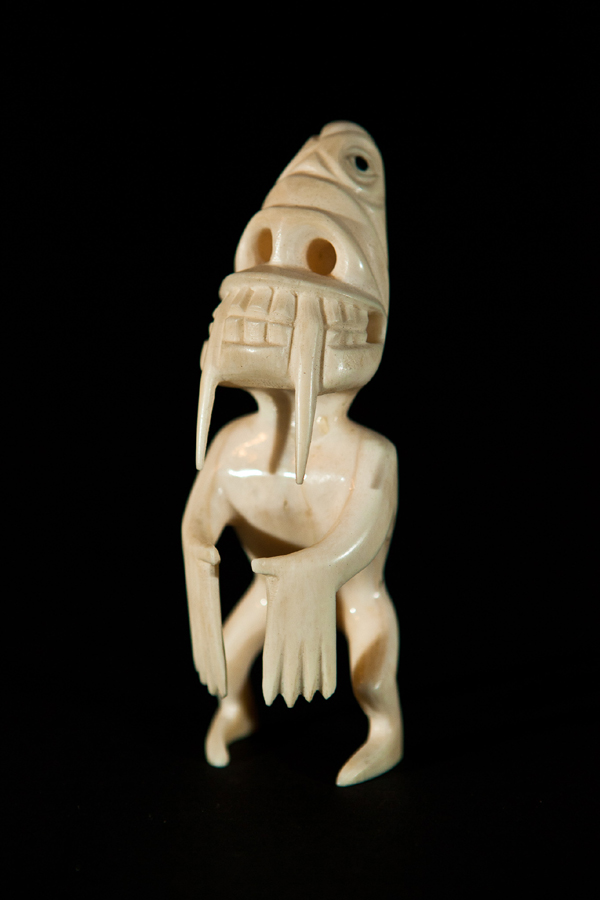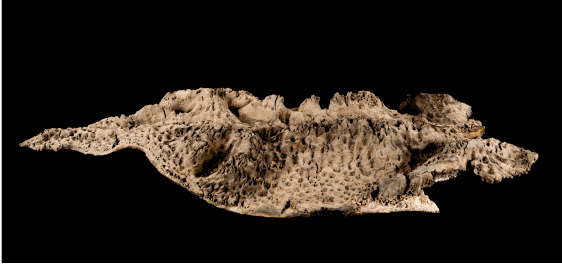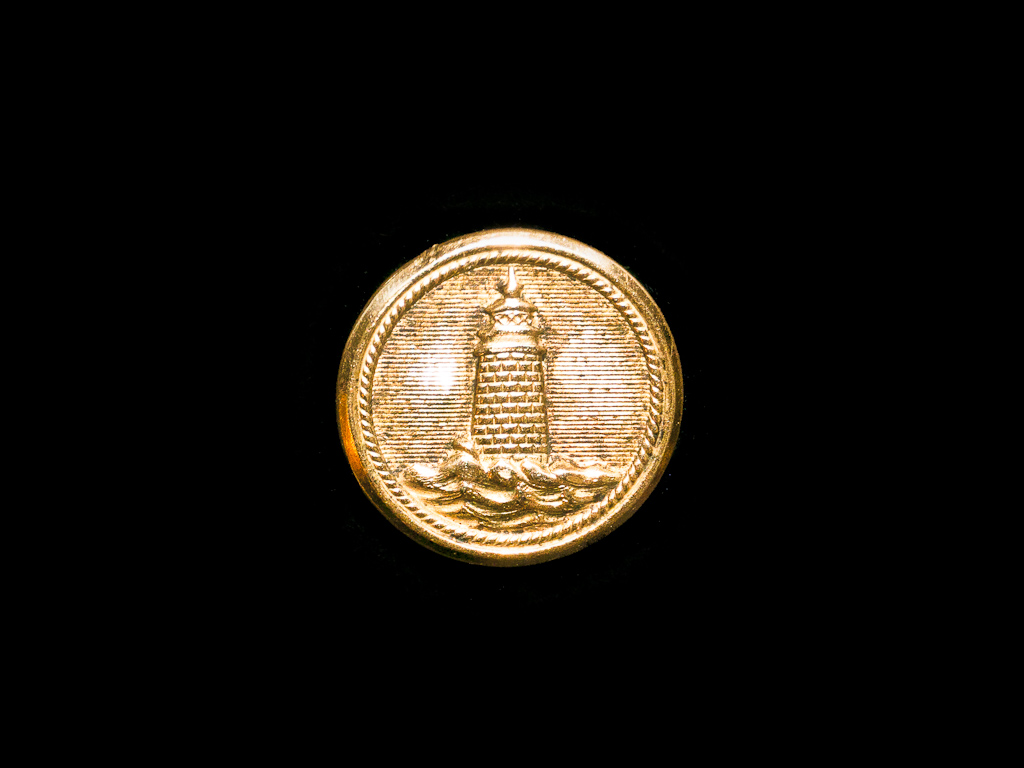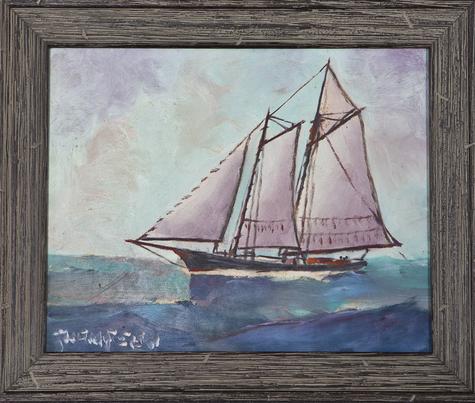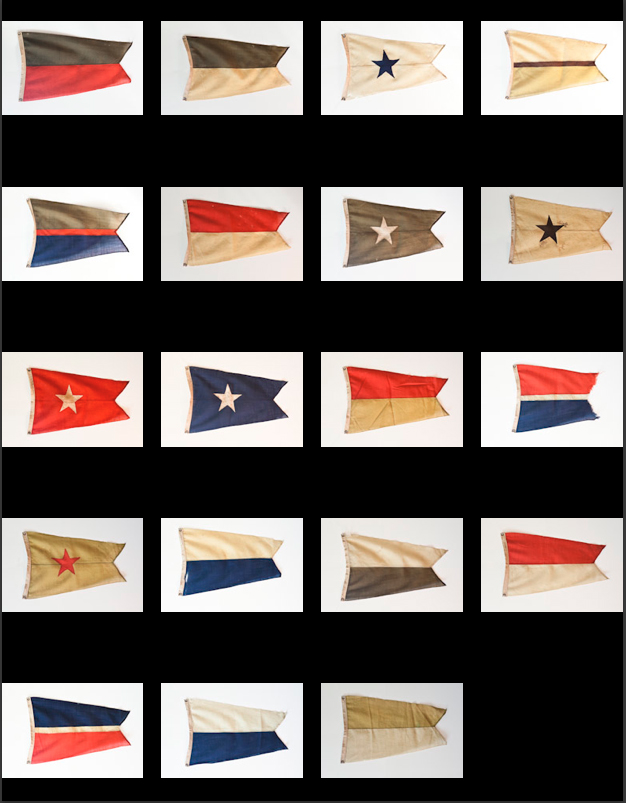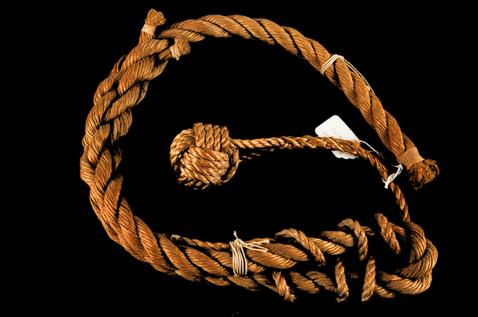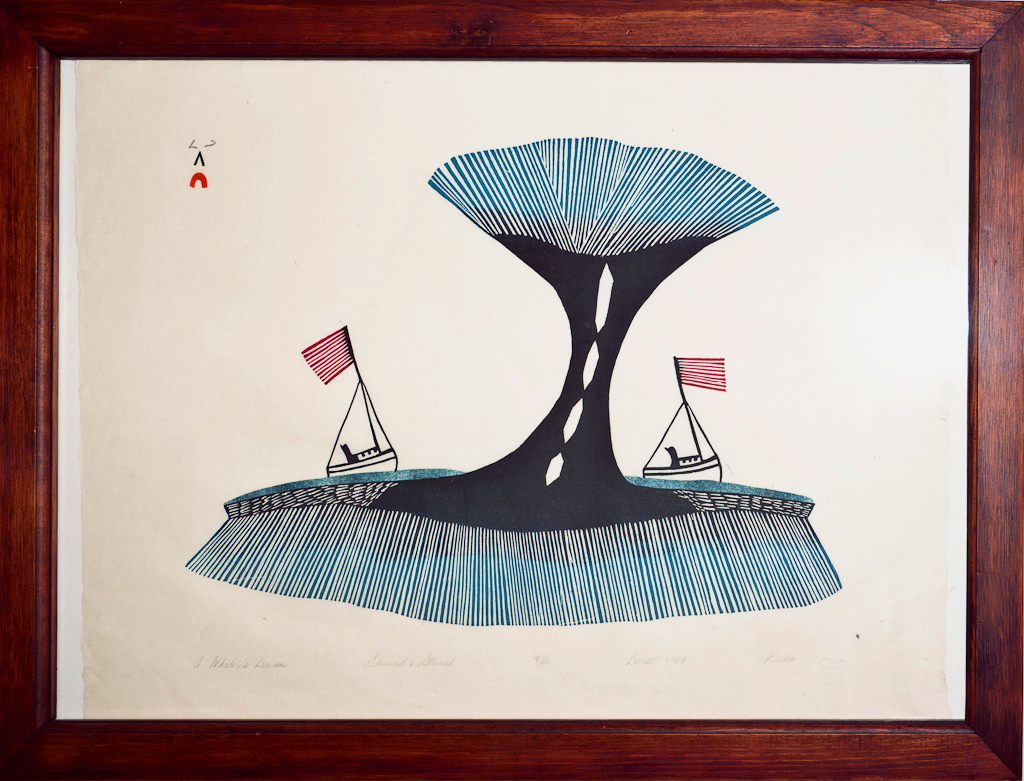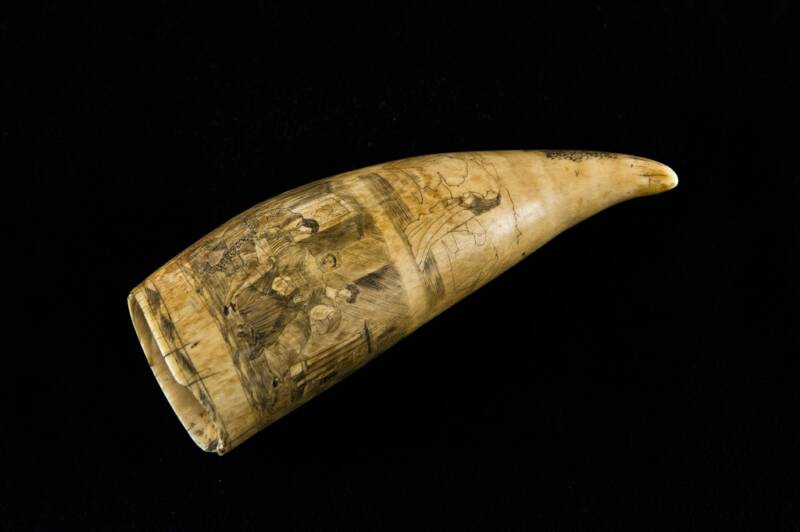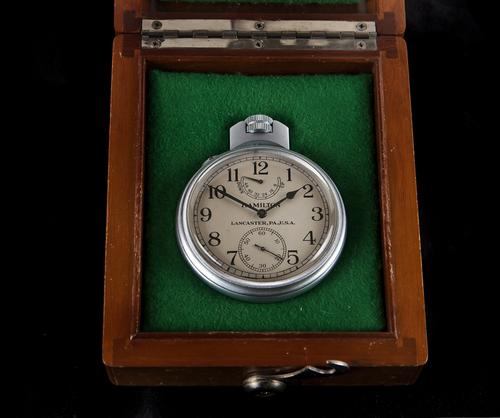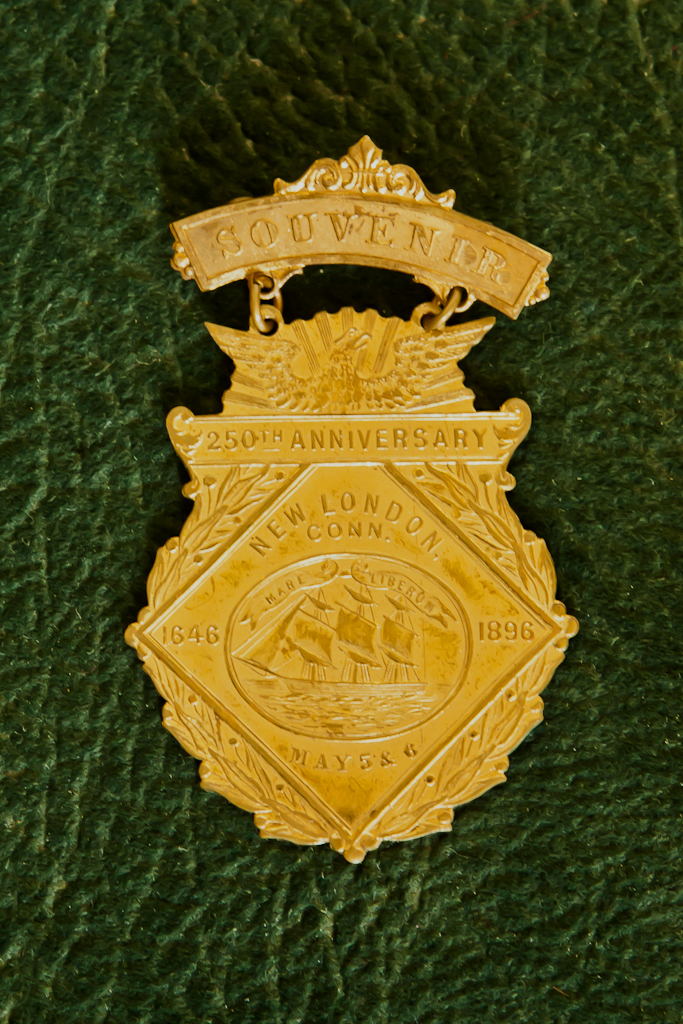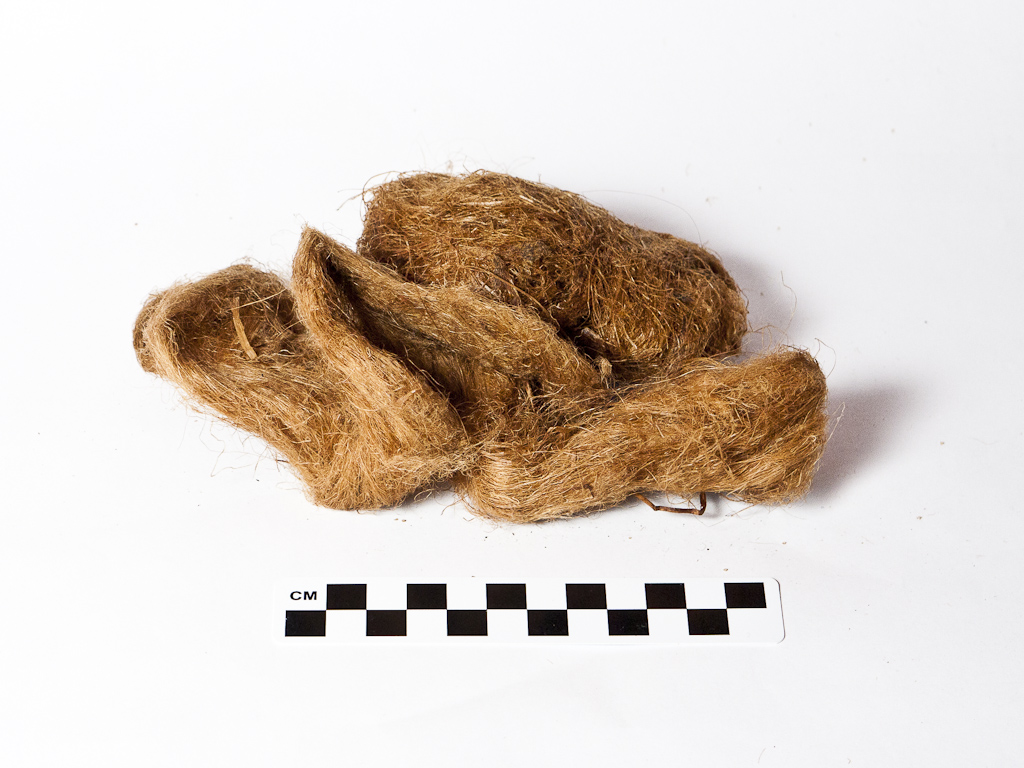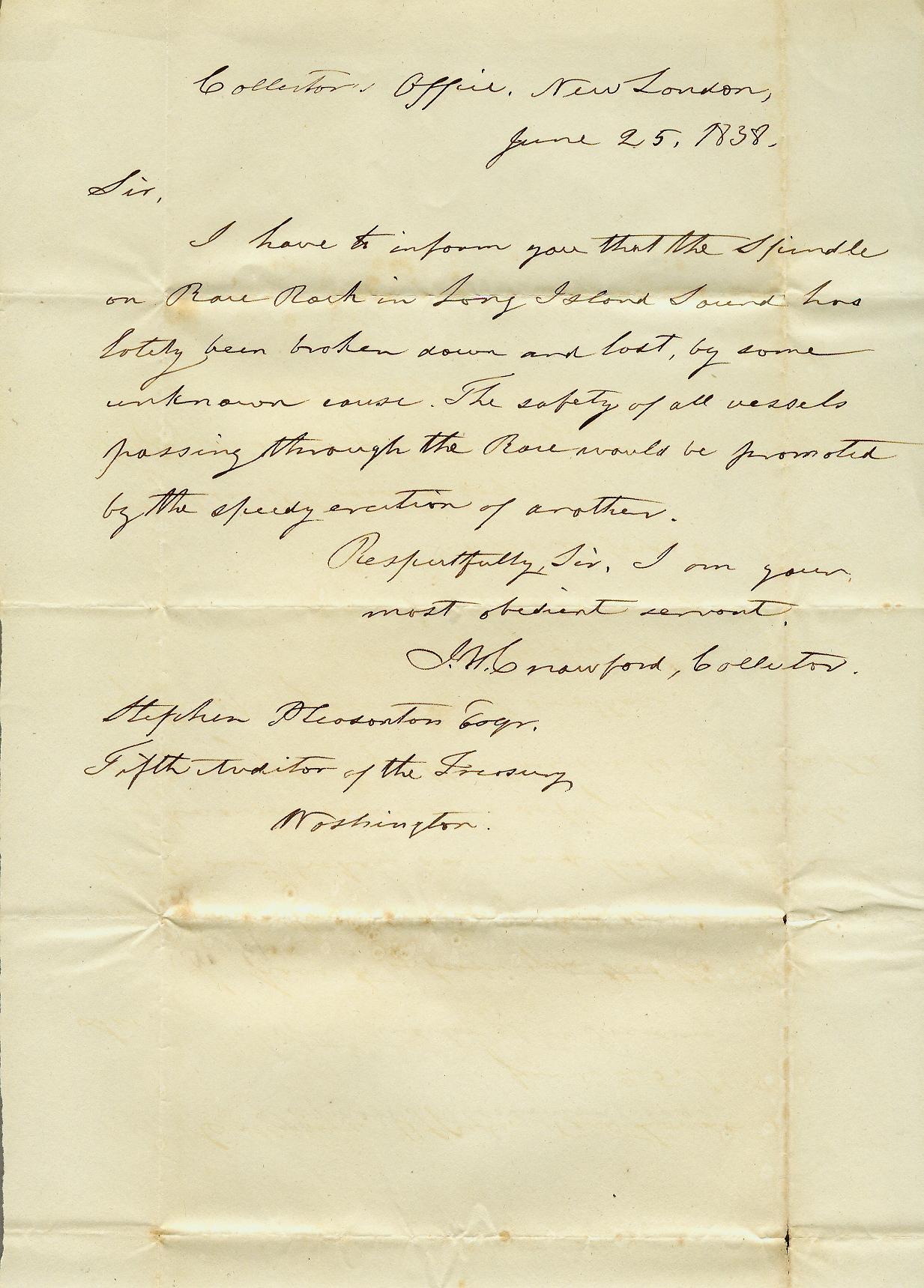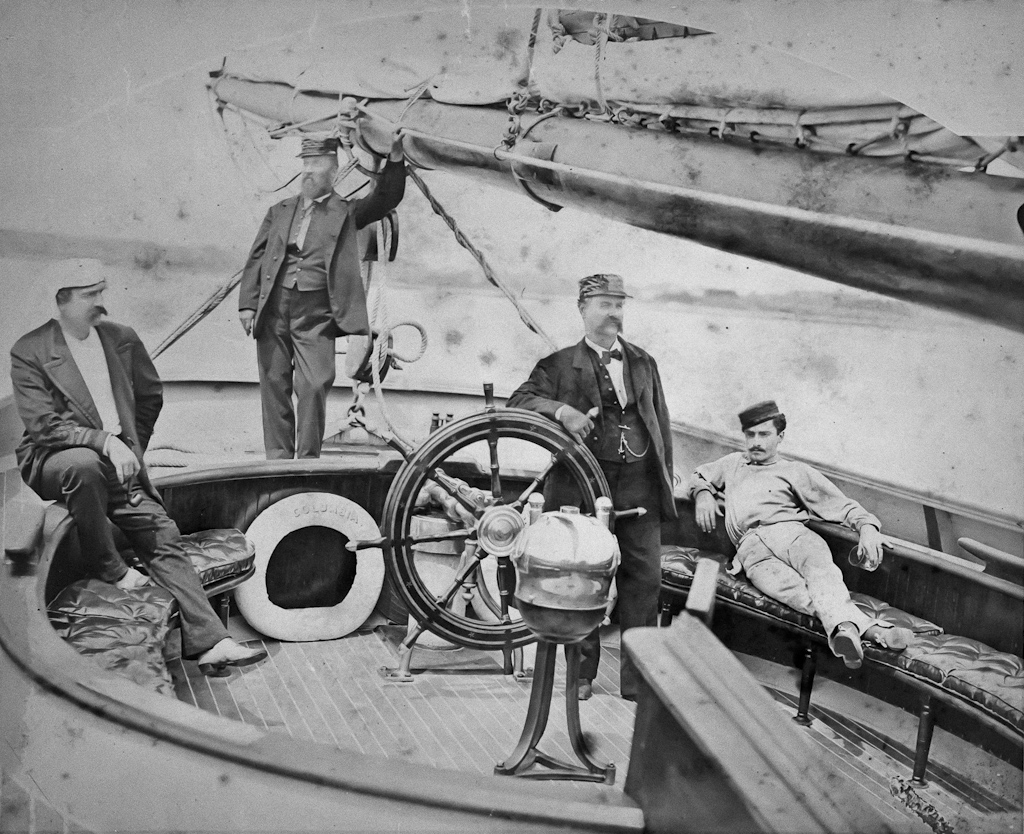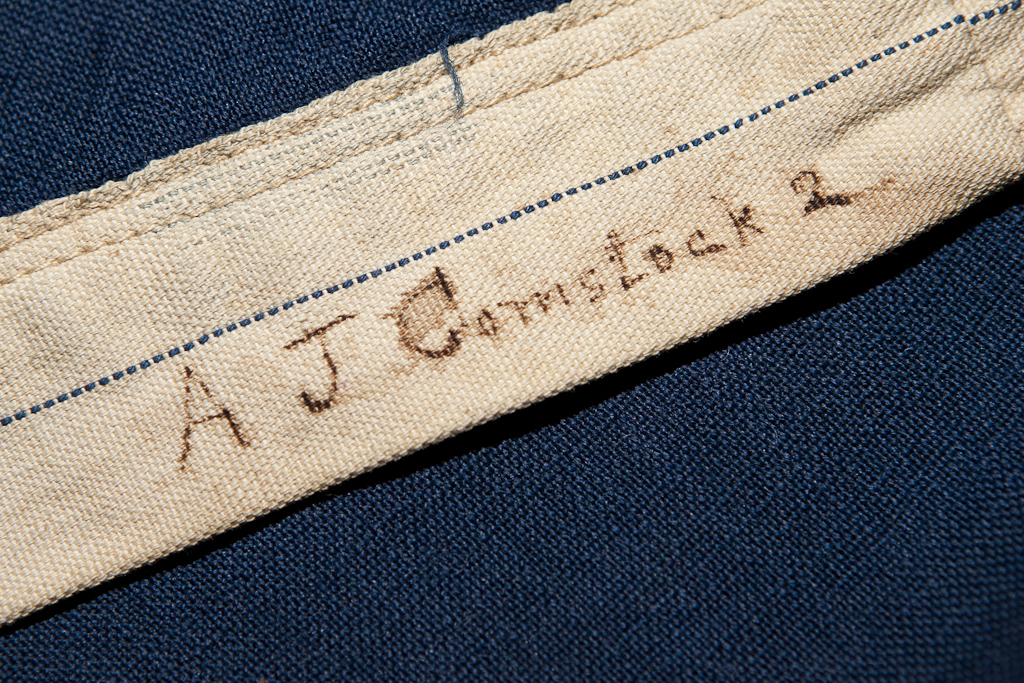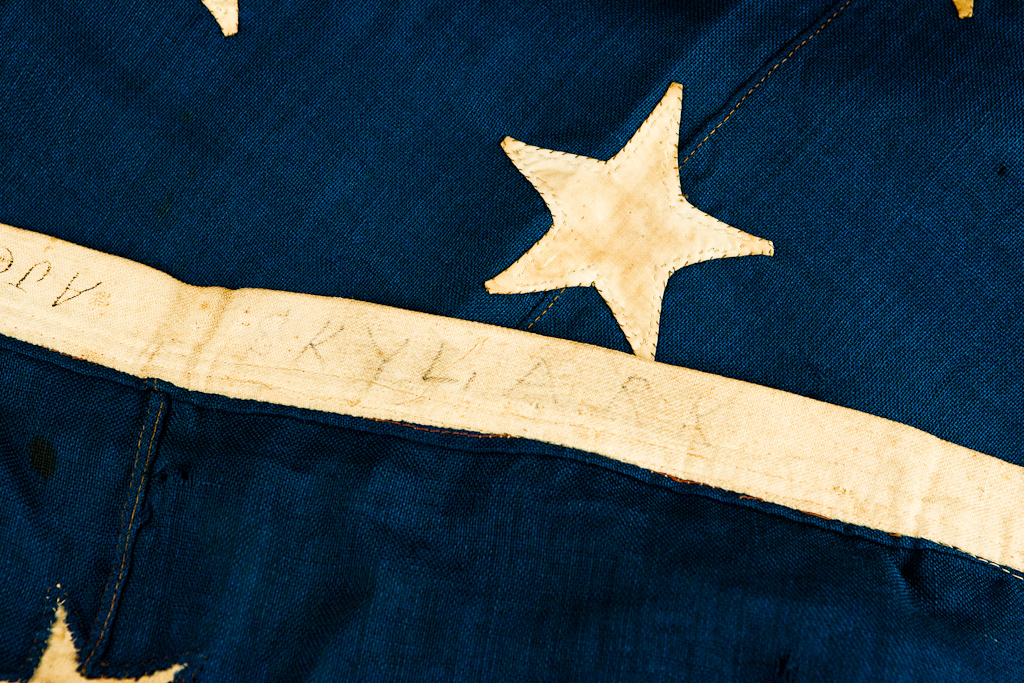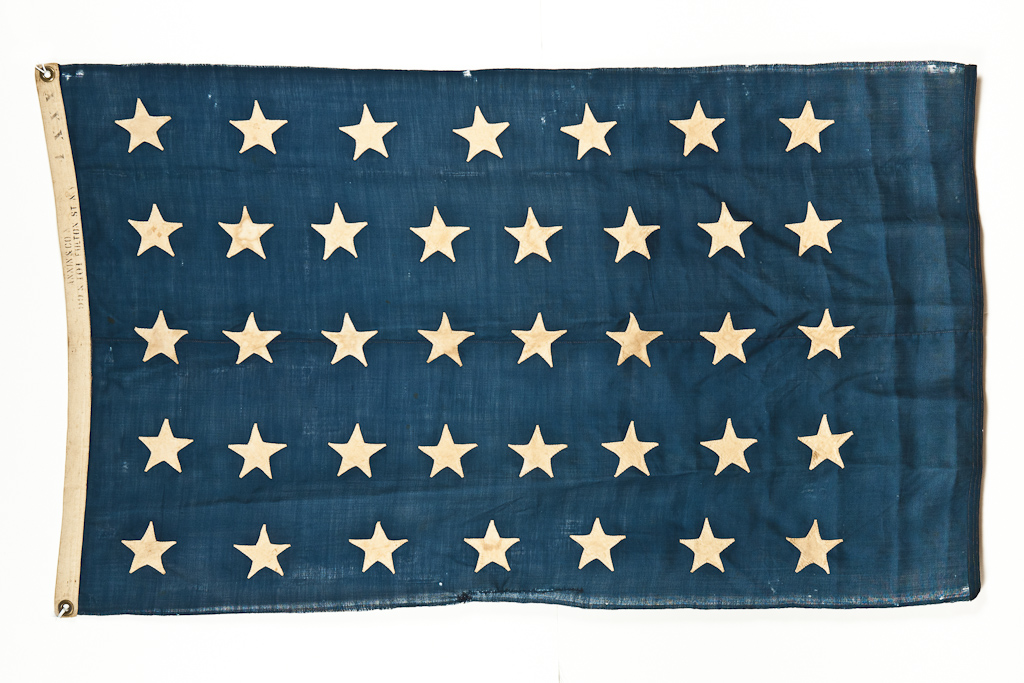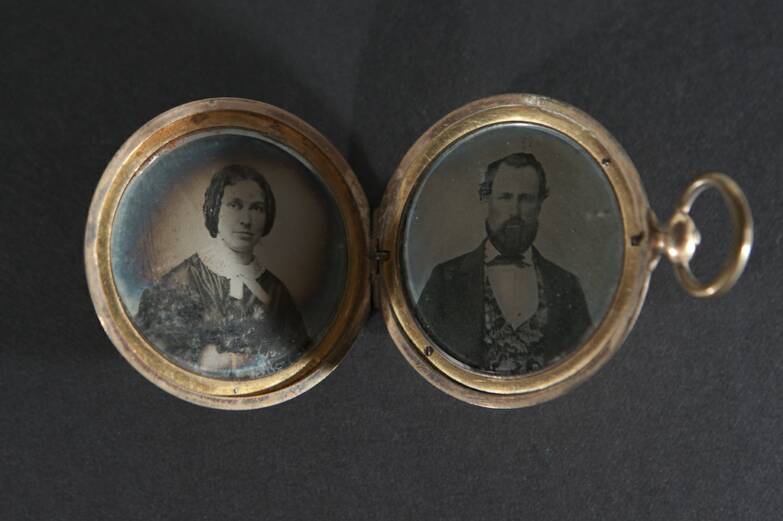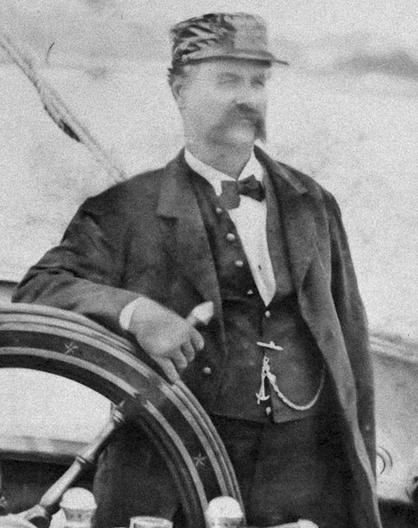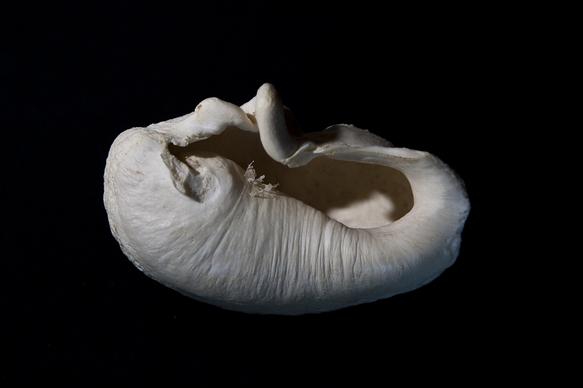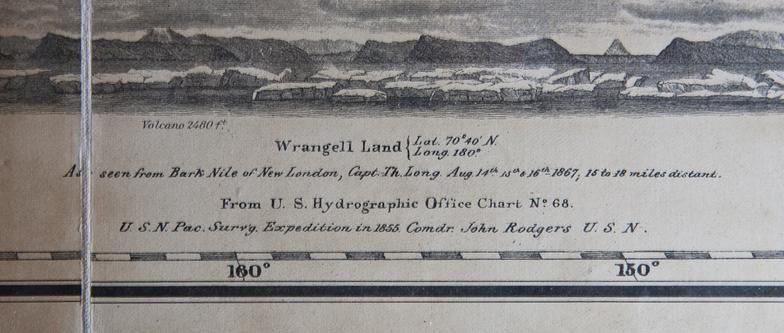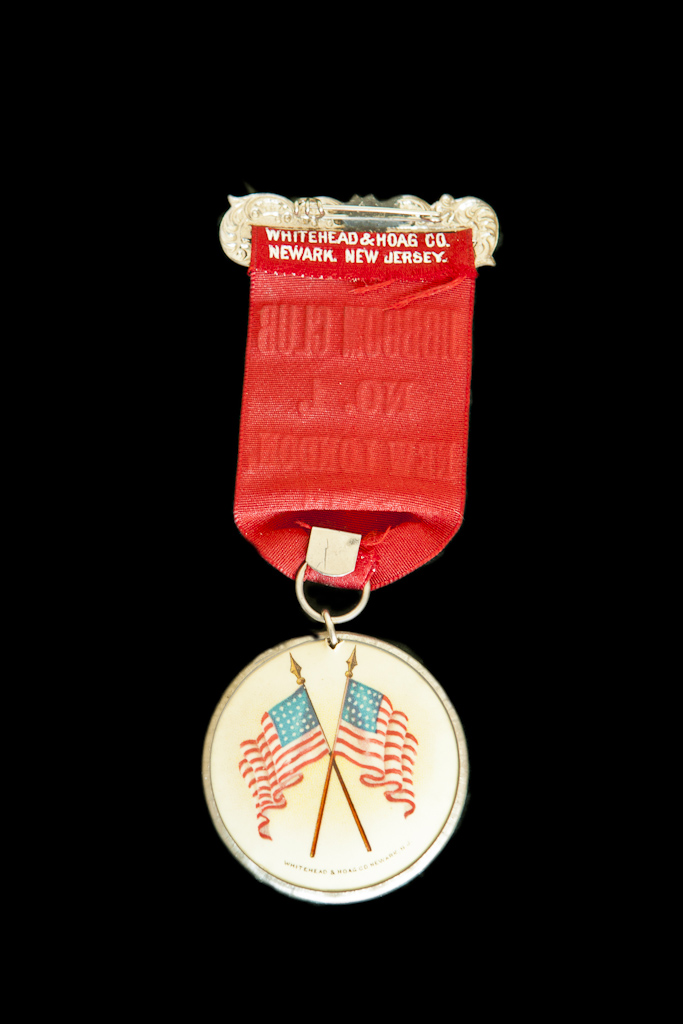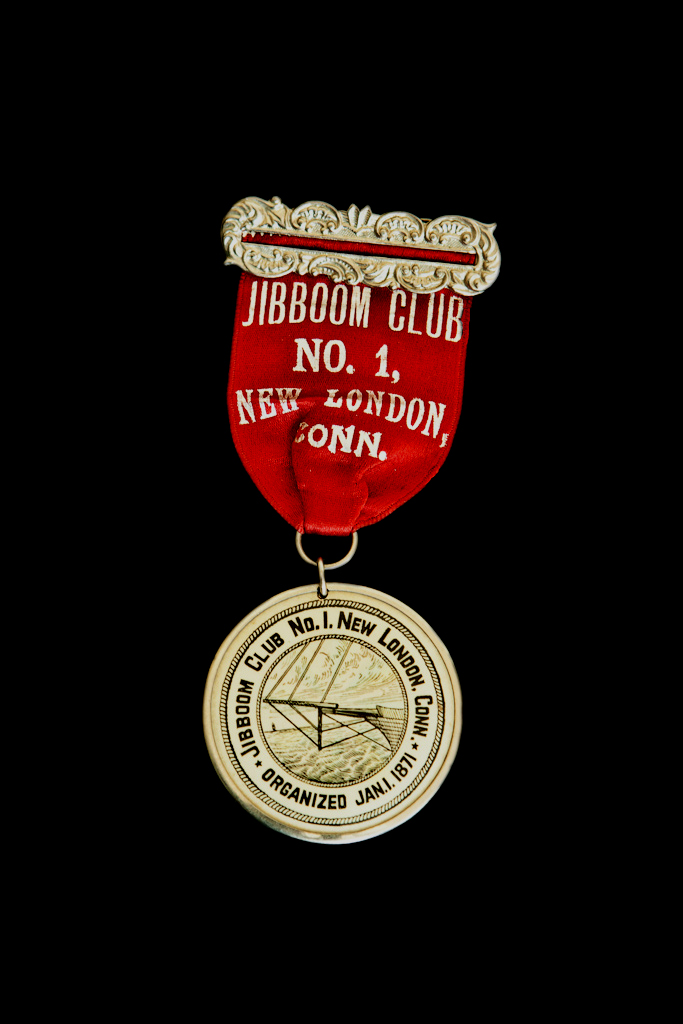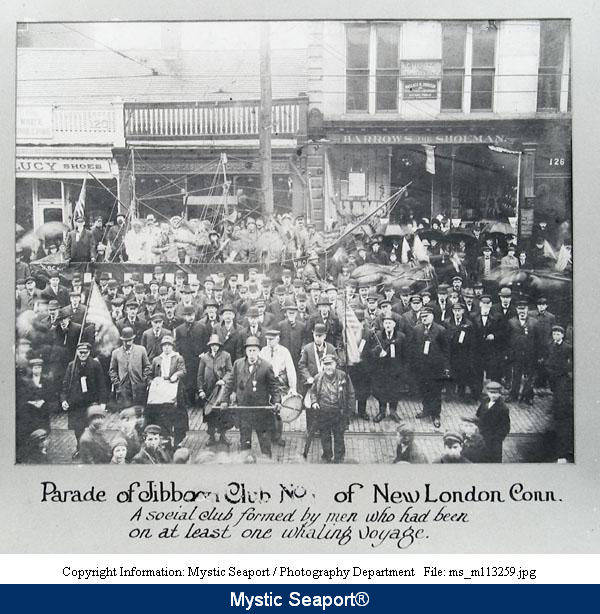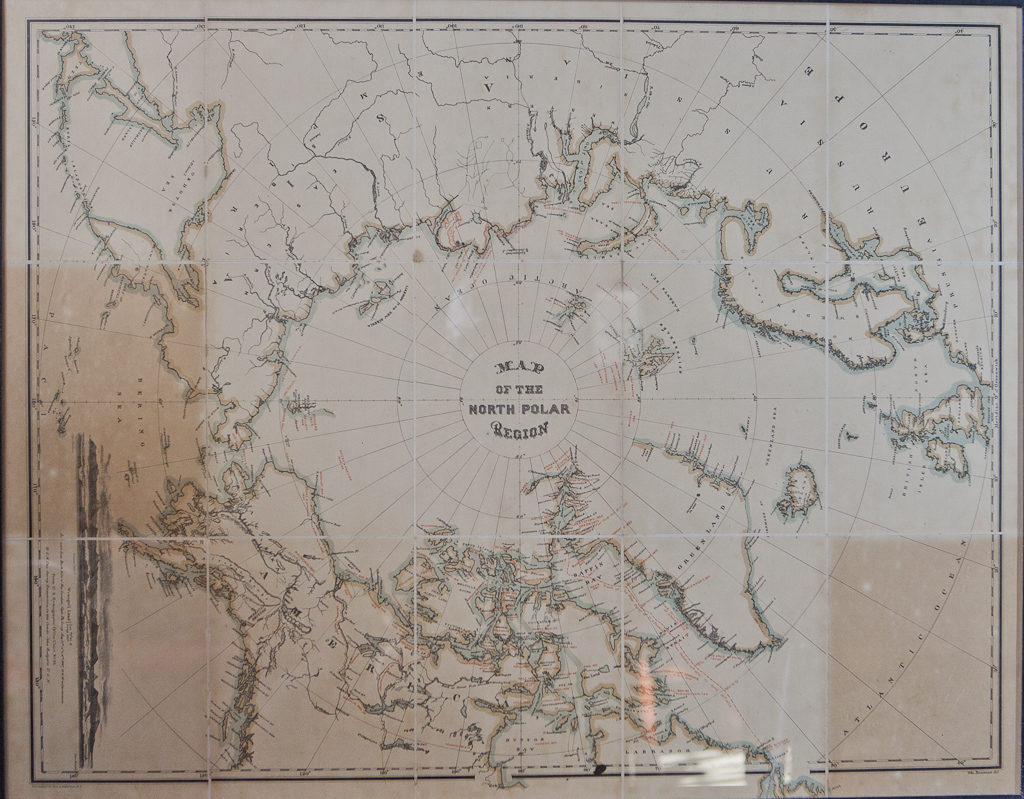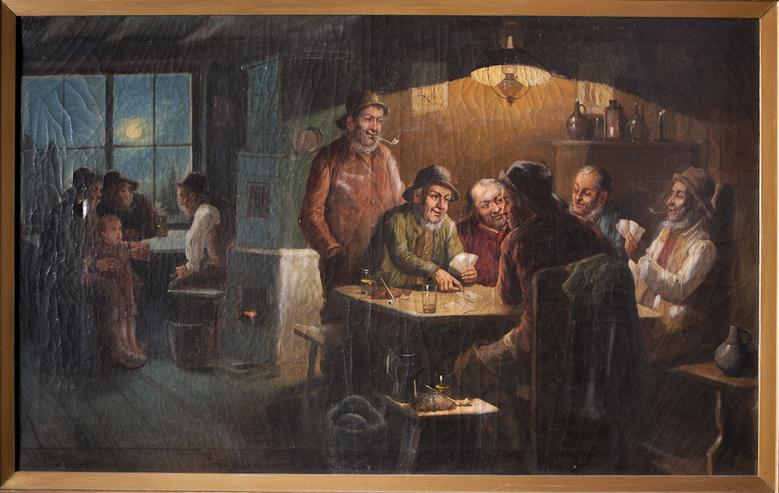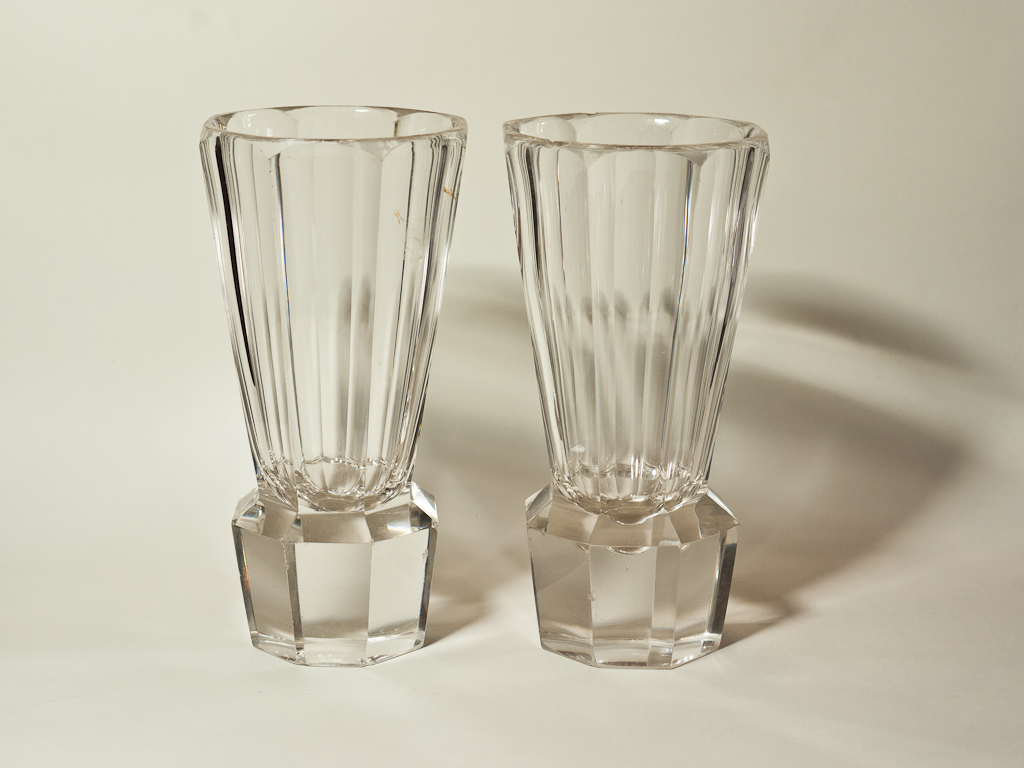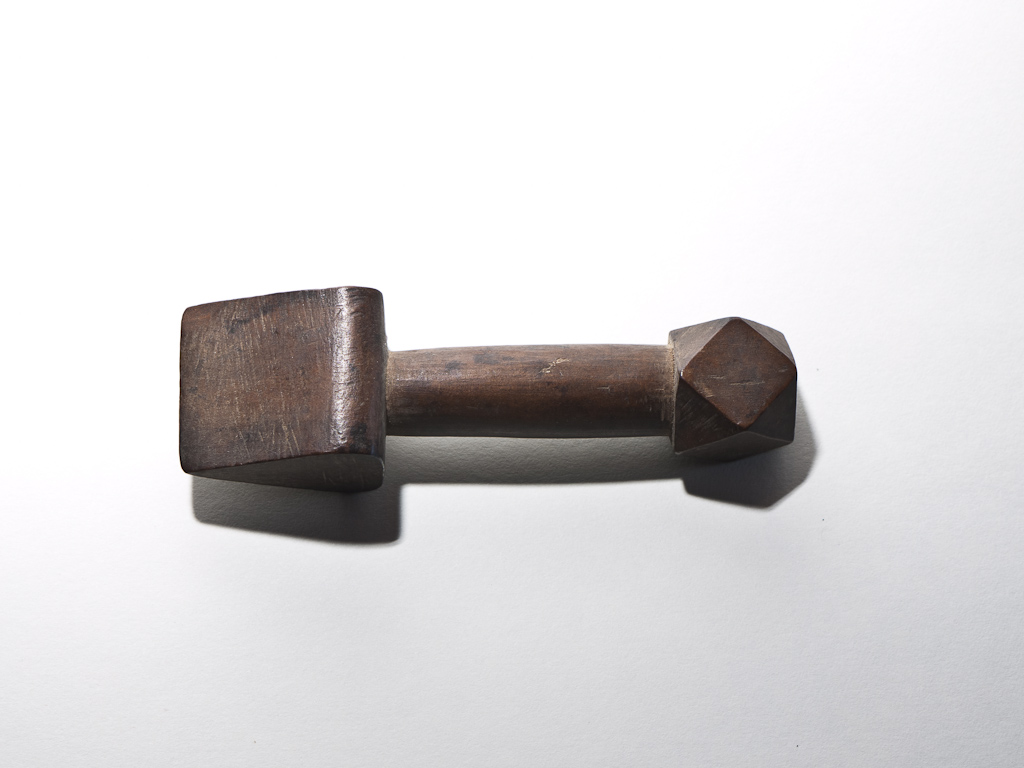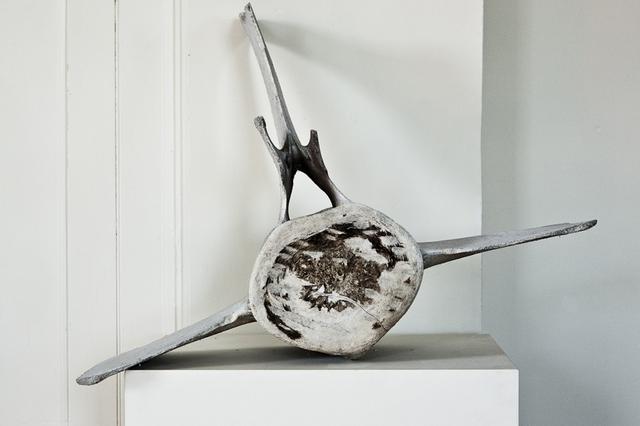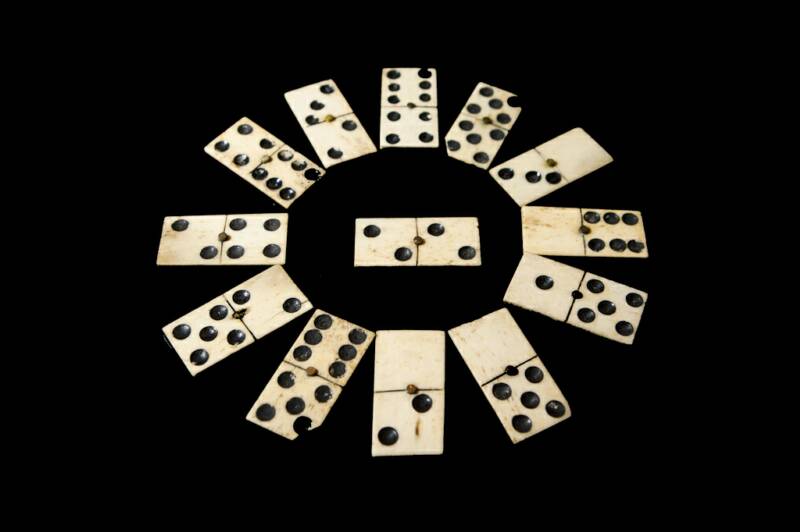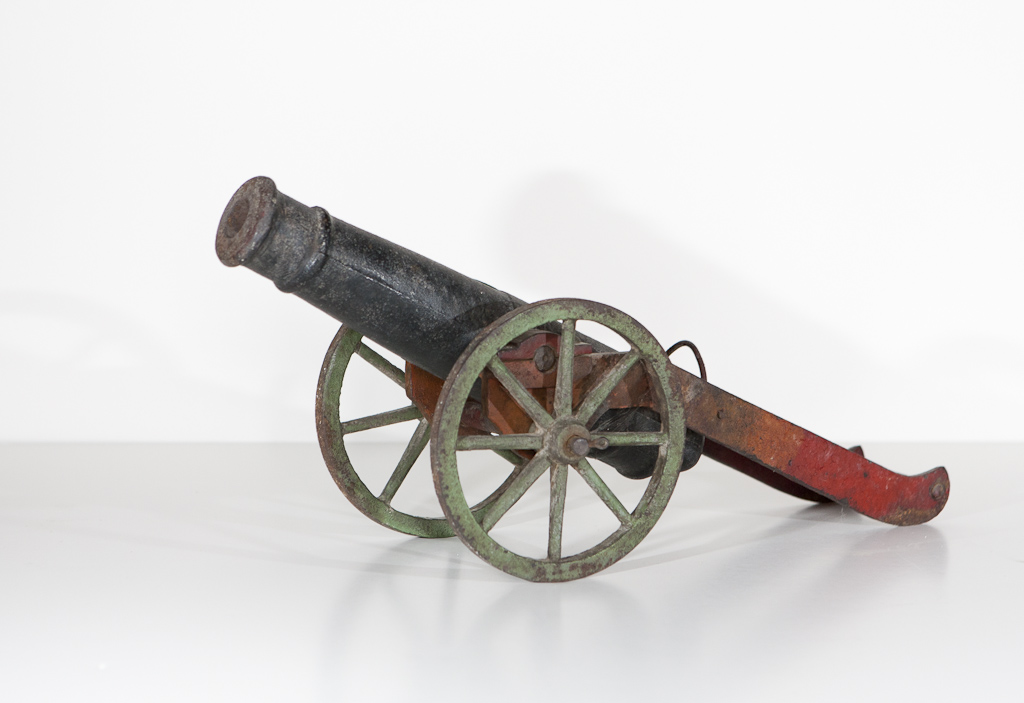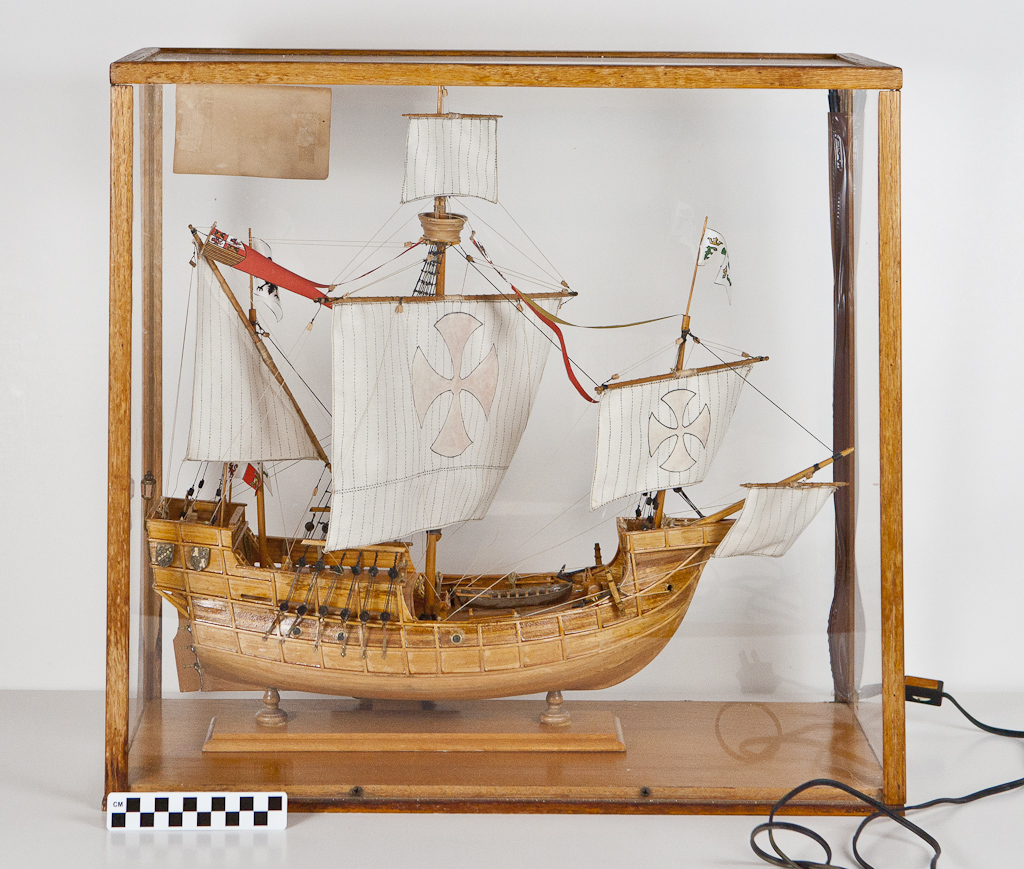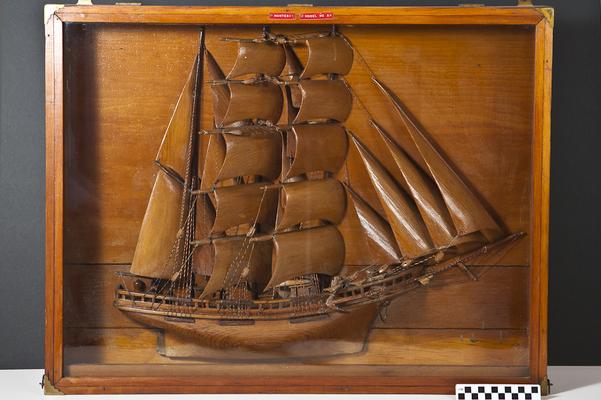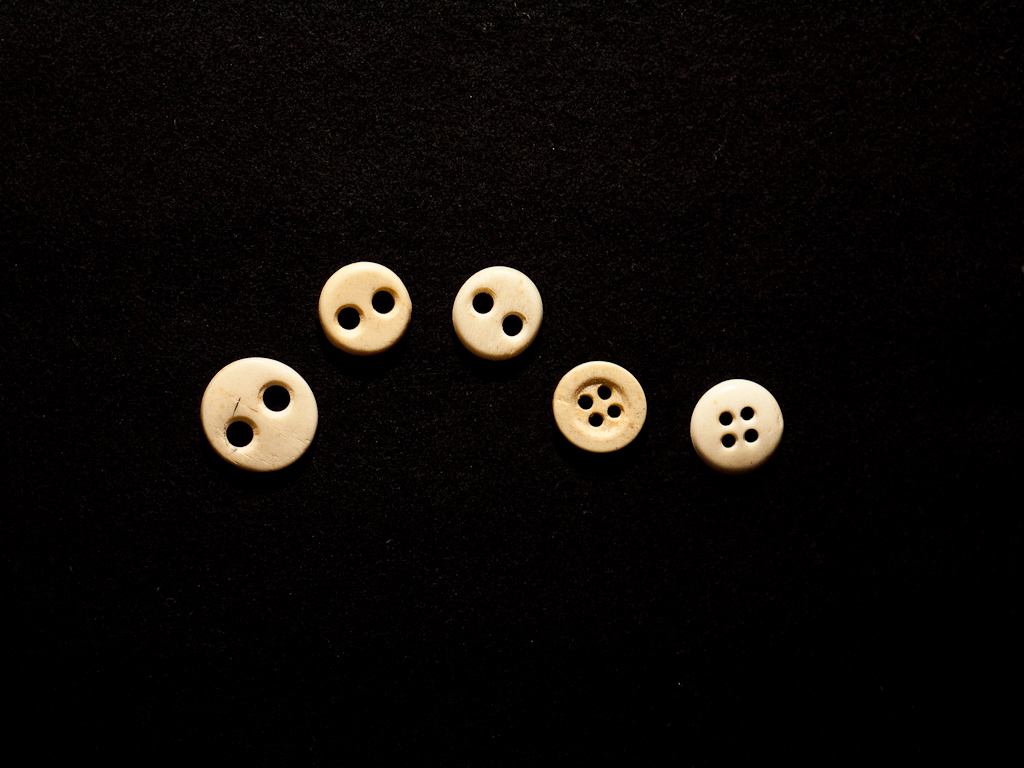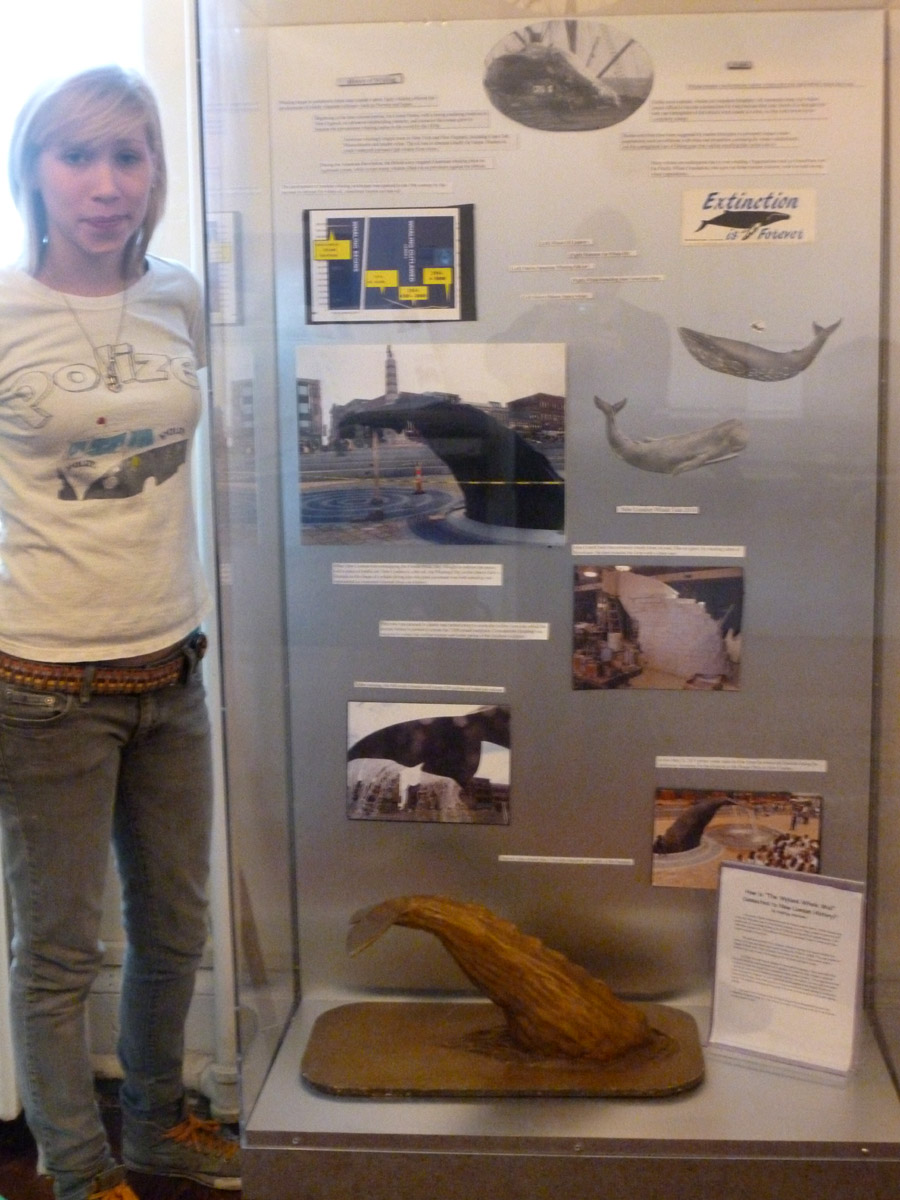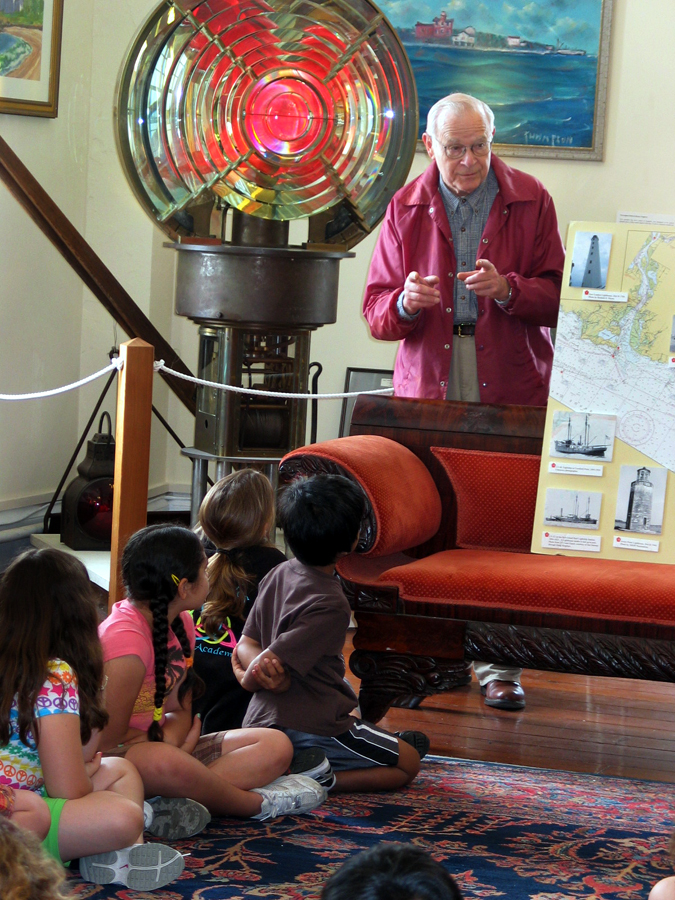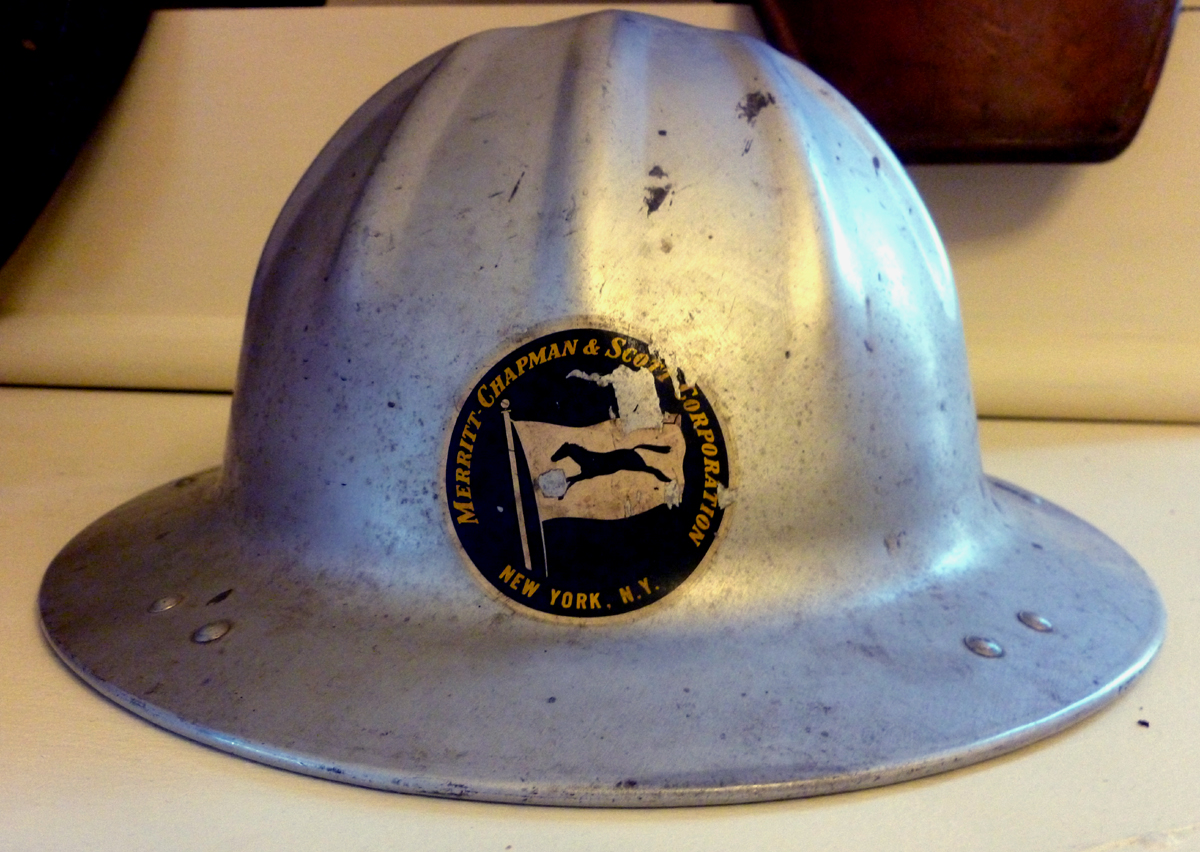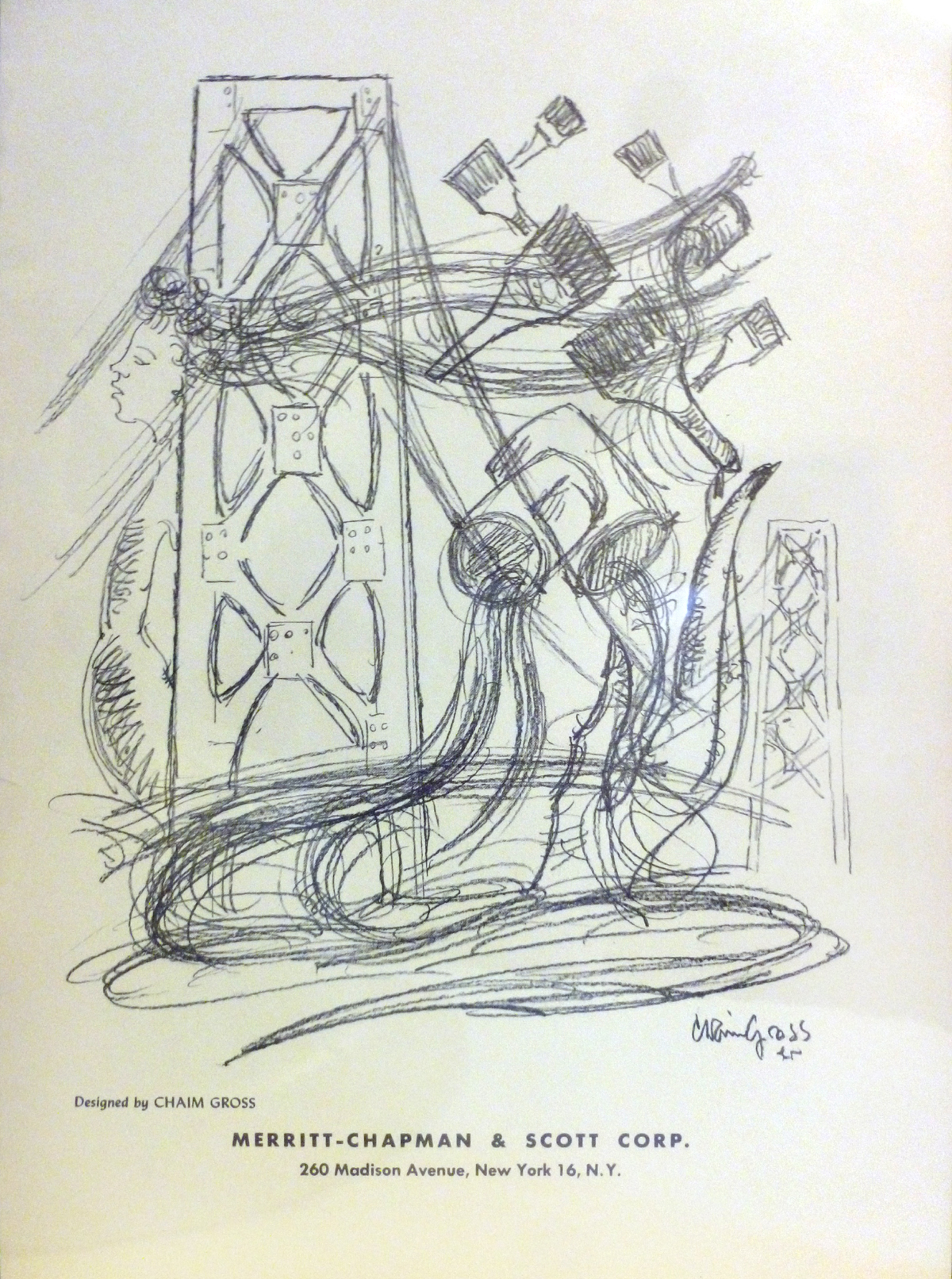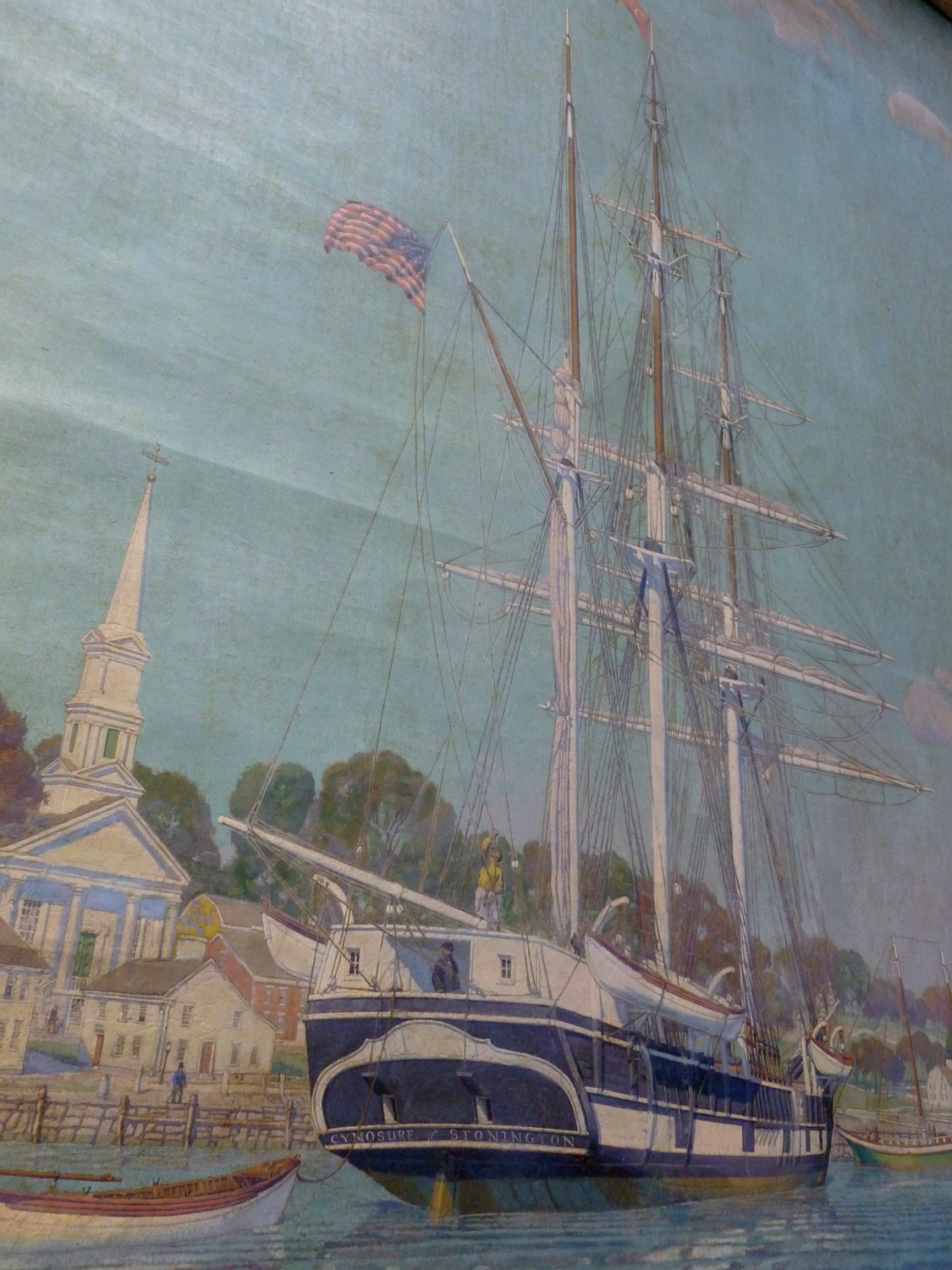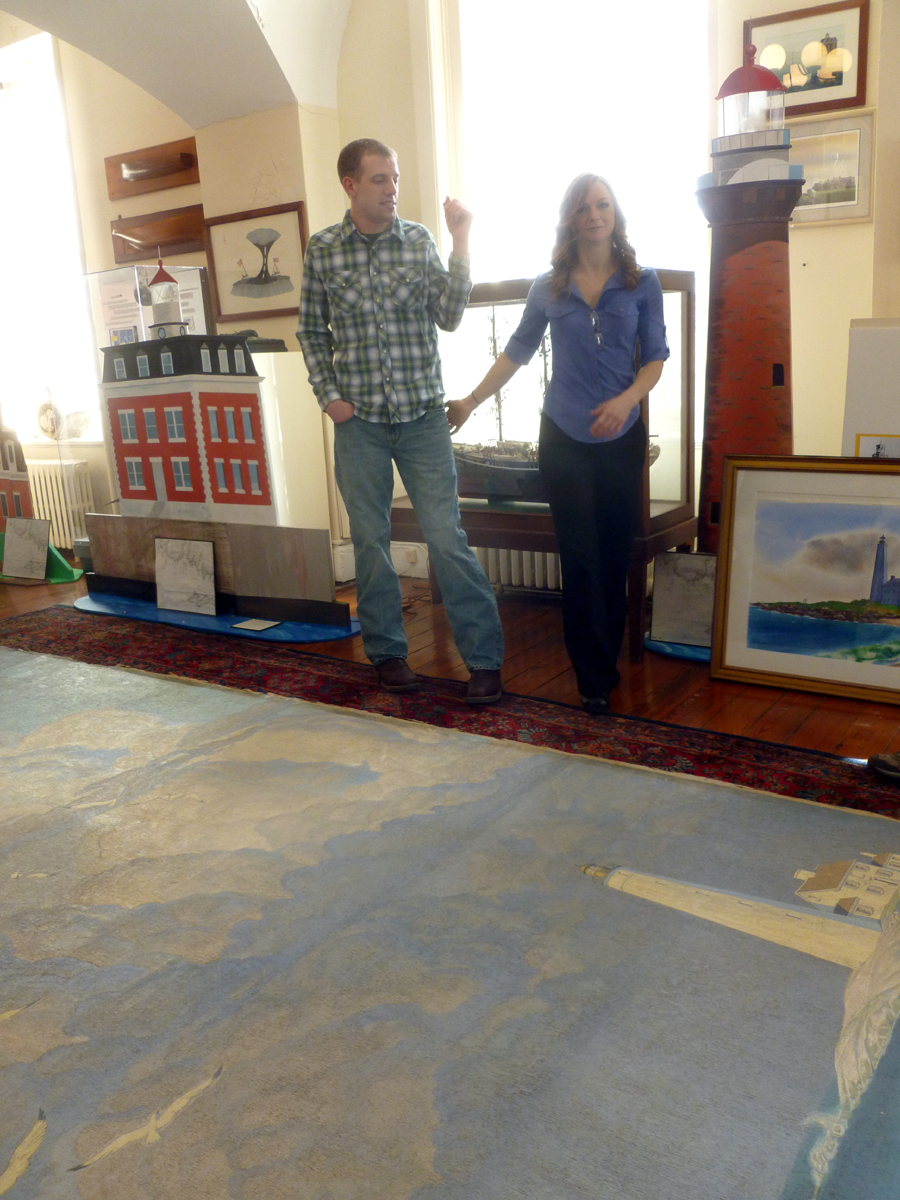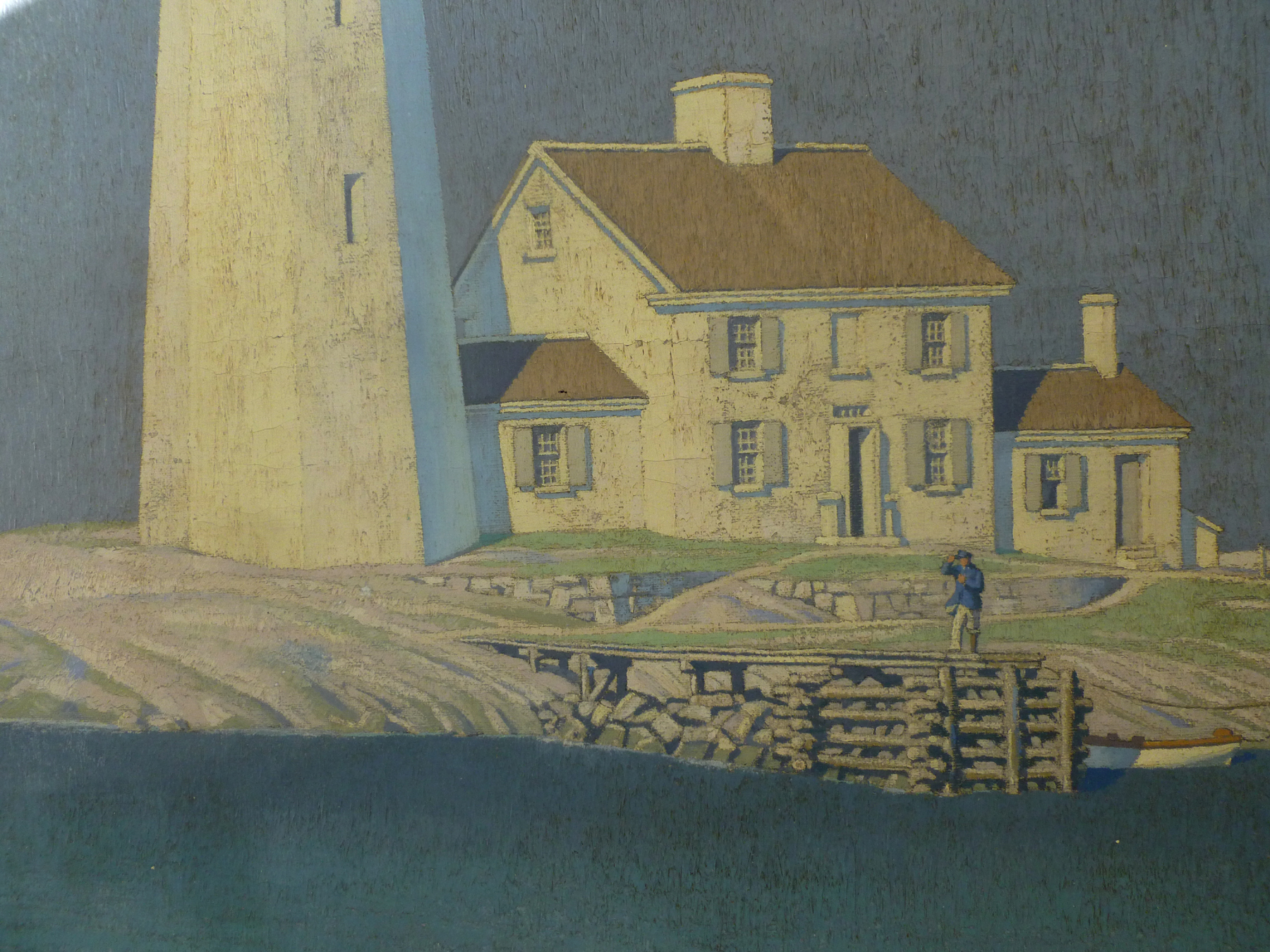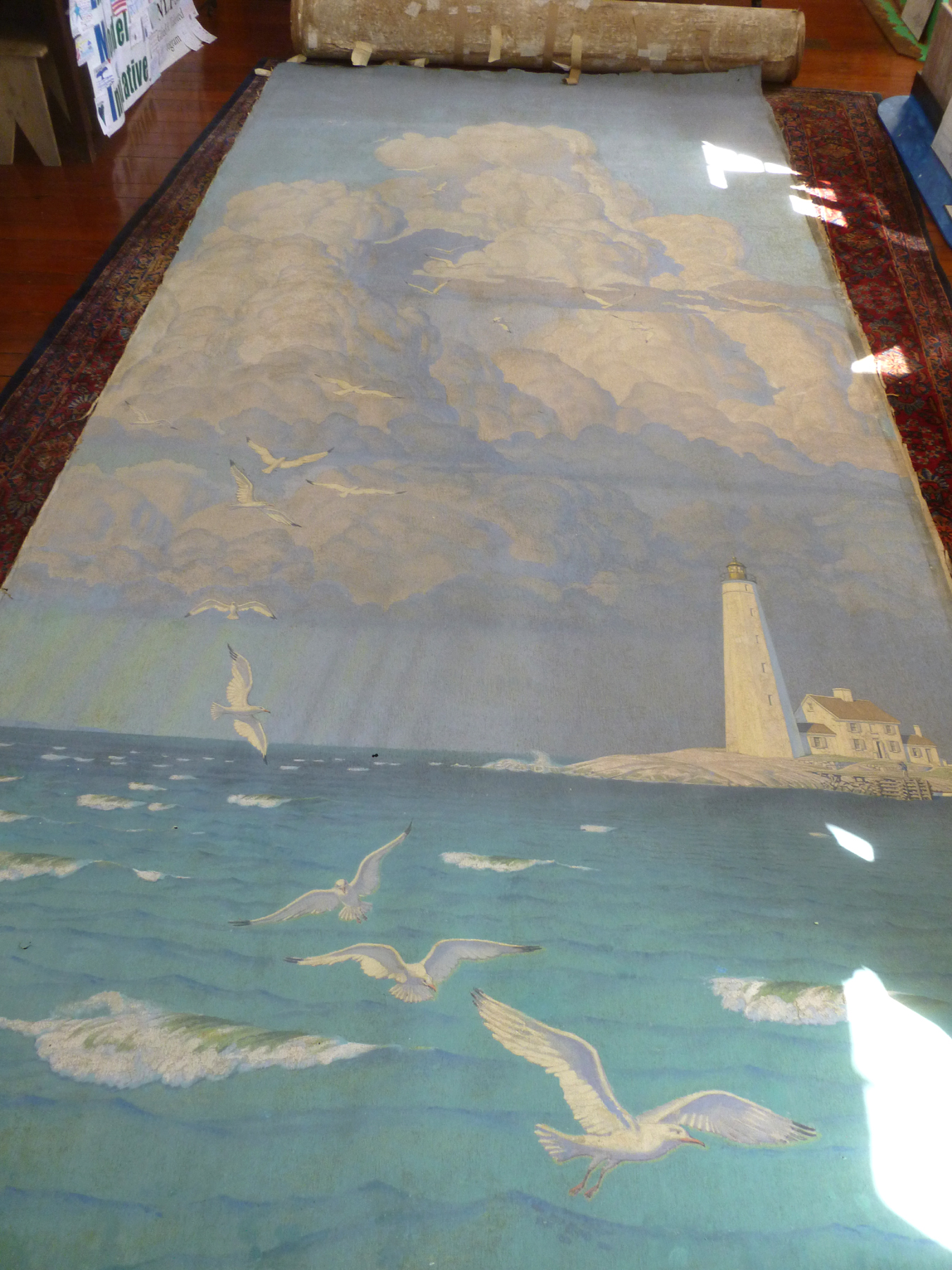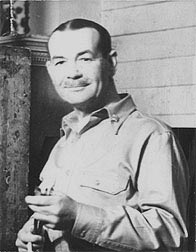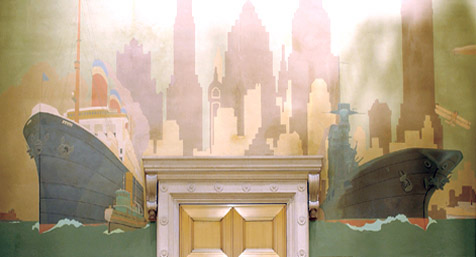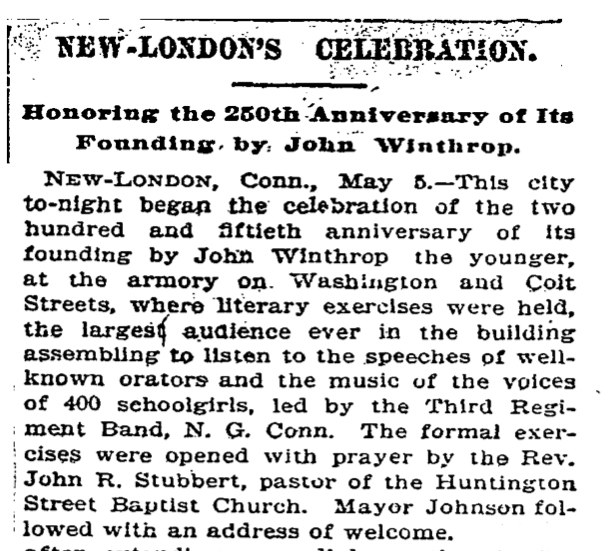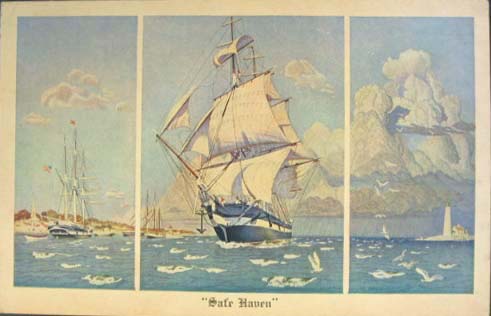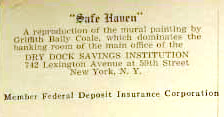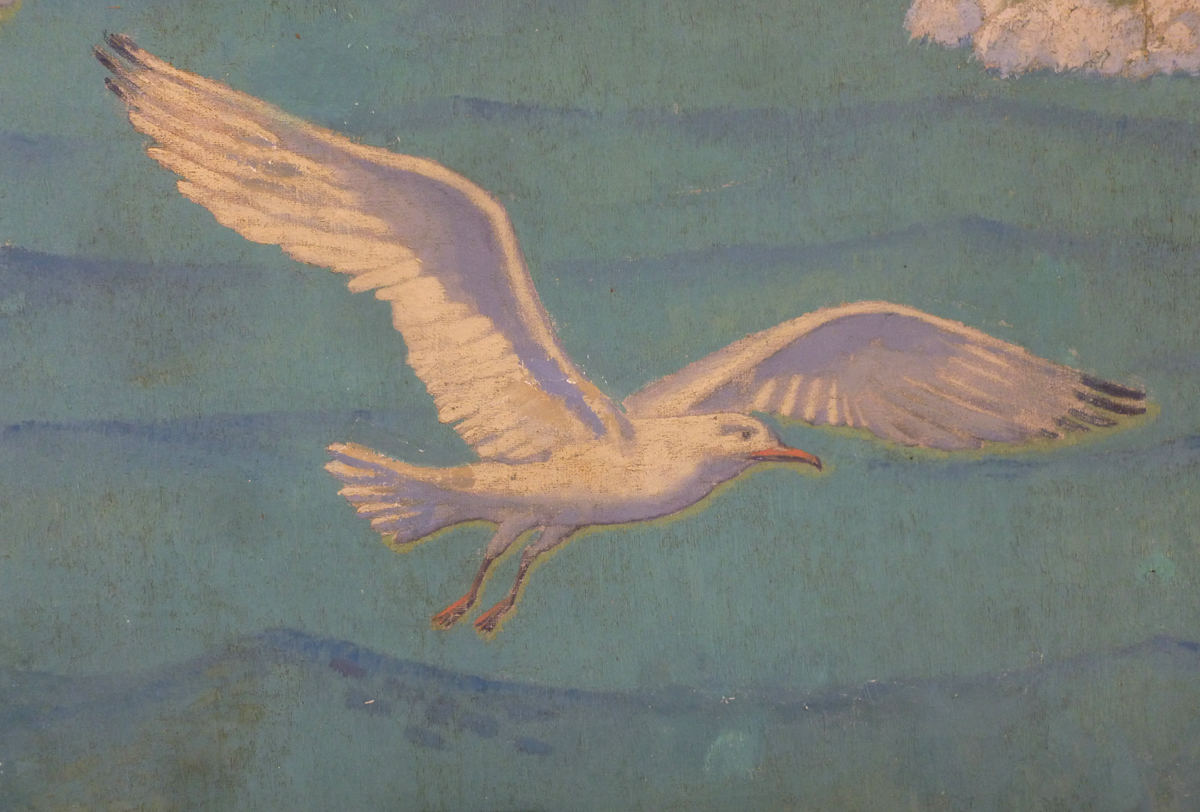April 4, 2011
Majolica Pitcher
This five-color majolica pitcher, 8 inches tall and 5 inches in diameter at the base, is decorated with molded fish, crabs, marine plants and gulls. Victorian majolica is earthenware pottery made in 19th-century Britain, Europe and the USA with molded surfaces and colorful clear lead glazes. This lovely example was used on the yacht, Columbia, about 1872.
Skippered by Andrew Jackson Comstock, Columbia defended during the 1871 America’s Cup challenge. Columbia won the first two races against the challenger, the Livonia. It was beaten by Livonia in the third race, in which Columbia, damaged from the second race, was skippered by Horatio Nelson "Nelse" Comstock. It was the first America's Cup defender to concede a win to the challenger. As Columbia was further damaged in this third race, it was unable to compete in the final race.
Columbia, a wooden center-board schooner, was designed and built in 1871 by Joseph B. Van Deusen for owner Franklin Osgood of the New York Yacht Club.
The pitcher was a gift to the Custom House Maritime Museum of Margaret A. Thoms, of Branford, grand-daughter of Andrew Jackson Comstock, May 19, 1987.
-- Robert W. Bowman
sources include Wikipedia
NB: We have been researching the America's Cup and its New London connections.
Andrew Jackson Comstock of New London also was skipper of the Magic - the first successful defender of the America's Cup in 1870.
April 11, 2011
Demitasse cup and saucer
The Norwich Line offered passenger steamship service between New London and New York City in the late 19th and early 20th centuries.
Service from New York departed weekdays at 5:00 PM and arrived in New London at 1:30 AM. New London to New York service left at 11:00 PM and arrived at 5:45 AM. The Line provided daylight and weekend service July through September. With two steamers—the City of Lowell and the Chester W. Chapin—it was one of several steamship companies owned by the New England Navigation Company of New York City.
Joseph Chapman Comstock, son of Andrew Jackson Comstock, was purser on the Line.
The cup and saucer was a gift to the Custom House Maritime Museum of Margaret A. Thoms, granddaughter of Andrew Jackson Comstock, May 19, 1987.
Source: The Blue Book of American Shipping, p. 339, Penton Publishing, 1911.
April 18,2011
Sewing tools, carved ivory
Sailors on whaling vessels passed idle time carving sperm whale teeth and walrus tusks to fashion a variety of items. They etched intricate scenes on larger teeth—scrimshaw—but also created tools, game boards and pieces, jewelry, buttons and other objects.
These seven sewing tools are among the many carved ivory pieces in the collections of the Custom House Maritime Museum.
May 2, 2011
Tupilak Figures
In the folklore of the indigenous Greenlandic Inuit, the word 'tupilak' refers to an ancestor's soul or spirit. A shaman called upon these spirits to overpower a foe by secretly carving a figure made from various bones or other parts of animals. By singing a spell over it, the shaman infused it with the tupilak spirit. The tupilak might then be cast into the sea to find and conquer the enemy.
Today, tupilaks of many kinds are carved from walrus or narwhal tusks or from reindeer antlers. Typically four to five inches tall, tupilaks are an important Greenlandic Inuit art form and are highly prized as collectibles.
These pre-WW II tupilak figures were a gift of the Frederick Vogt family to the New London Custom House Maritime Museum.
Source: Greenland.com/kultur-sjael/kunsthaandvaerk/tupilak.aspx
May 2, 2011
Whale Bonnet: "A peculiar growth from the front of a right whale's head"
The right whale has roughened skin patches, which commonly appear on the top of the whale’s head, and on its chin, jaw and above the eyes.
The patches are called “callosities,” but the whalers called them “bonnets”. They are the same color as the whale’s skin but appear white or yellow due to the presence of thousands of tiny crustaceans called cyamids, or “whale lice.”
Researchers use these callosity patterns to identify individual whales.
The whale bonnet in the collection of the Custom House Maritime Museum is among the objects that belonged to the Jibboom Club of New London, which was founded in the 1870's by the officers of whaling vessels. This whale bonnet is 24” long.
http://marinelife.about.com/od/vertebrates/p/rightwhale.htm
May 9, 2011
United States Lighthouse Service, Brass Button
At only 3/4 inch in diameter, this brass button is among the smaller but no less historic items in the Custom House Museum collection. Buttons of this design were adopted by the Lighthouse Service around 1900. The button is stamped to form a raised relief of the Minot's Ledge lighthouse, which is located about a mile offshore, near the line between the South Shore towns of Cohasset and Scituate, Massachusetts. On the reverse, around the perimeter of the button, the manufacturer's name is stamped, "Waterbury Button Co." In business since 1812 the company, located in Waterbury CT, manufactured buttons for both the Union and Confederate armies, and is still the pre-eminent maker of stamped brass buttons for the military, law enforcement, clubs and organizations, brass bands, and the like.
May 16, 2011
"Schooner Yacht America," Oil on masonite, Ellery Thompson, 1967
This painting is by Ellery Thompson. Born in Mystic in 1899, Thompson was a dragger boat captain in and around New London for half a century, as well as a storyteller, author, and painter. He died in 1988. Thompson was profiled in The New Yorker in a two-part piece by Joseph Mitchell, January 4 and 11, 1947. Mitchell wrote:
Ellery--he says he is called Captain Thompson or Mr. Thompson only by people who want to get something out of him--is captain and owner of the gasoline dragger Eleanor.... He is also a self-taught oil painter.... His paintings, most of which are marines, hang in fishermen's homes and dockside saloons all over eastern Connecticut.*
And now in museums.
The painting is 9" by 11", including frame, and is signed in the lower left corner, and signed and dated 1967 on reverse, in painted script. Also stamped on reverse, “By Ellery Thompson, Mystic Conn.
Kindly donated to the Custom House Maritime Museum by Robert Stewart.
*Mitchell, Joseph. "Profiles: Dragger Captain. I" The New Yorker. January 4, 1947, p. 35.
Items below selected, photographed and compiled by Rob Bowman.
May 23, 2011
Dress Flags, Racing Schooner Columbia, Victorious America's Cup Defender, 1871
The racing schooner Columbia won the second America's Cup defense, in 1871. As in 1870, in which the Magic defended successfully, the captain of the Columbia was New London's Andrew Jackson Comstock. He was skipper during the first two races, with his brother, Henry Nelson "Nels" Comstock, also of New London, the skipper in the third. Columbia defeated the challenger, Livonia, in the first two races, but lost in the third, due to damage to her rigging and steering gear.
Of the several Comstock brothers, five "were sailors of fishing smacks in the winter and yachts in the summer."* Though less well-known than A. J. Comstock, Henry Nelson Comstock was mate on the America during her Atlantic voyage to England and her subsequent victory in the Isle of Wight race, in 1851. It was for this race that the Cup was named.
These flags--though more than a century old--are still strikingly beautiful. Each is numbered and each bears the name, "A. J. Comstock" on the hoist. They are among the priceless maritime objects generously donated by the late Margaret Comstock Thoms to the Custom House Maritime Museum. She was, respectively, the great-grand-daughter and great-grand-niece of Andrew Jackson Comstock and Henry Nelson Comstock.
We are grateful to David Martucci, Past President, North American Vexillological Association, and John Rader, Jamestown RI Yacht Club, for their help in identifying the flags.
*Shaw, David W. America's Victory: The heroic story of a team of ordinary Americans--and how they won the greatest yacht race ever. New York: Free Press, 2002.
May 30, 2011
Weighted Heaving Line, "Monkey's Fist"
A braided line with a knotted ball, or "Monkey's Fist" at the end, and with whipped ends, was used to weight a line so it could be thrown to shore or another ship. It was then attached to a heavier line or cable, which could then be drawn to the ship. Heaving weights were sometimes made of a stone, a small bag of sand or a lead weight, but the Monkey's Fist, sometimes fashioned around a heavier object, is neat, made of materials readily at hand ship-board, and can be used many times.
Probably made of hemp, the line and Monkey's fist in the collection of the Custom House Maritime Museum is 36 inches long.
June 6, 2011
Inuit Print, "A Whaler's Dream"
This vibrant print, "A Whaler's Dream," a stone-cut and stencil piece, recalls whaling in the far north as visualized by an Inuit artist of Cape Dorset, in the Canadian Arctic.
In 1959, the small community of Cape Dorset in the Canadian Arctic was introduced to the ancient traditions of Japanese printmaking by James A. Houston, an artist who studied in Japan with Un’ichi Hiratsuka, one of the world’s leading masters of the art.
Upon his return to the Arctic, Houston shared his knowledge and his collection of Japanese prints with the fledgling printmakers of Cape Dorset. The art of Inuit printmaking flourished, becoming a major source of income for the Inuit.
Among those that Houston introduced to printmaking was the artist of this print, Pudlo Pudlat, known as Pudlo. He became a widely known Inuit artist. His works are in the collections of most Canadian museums. At his death in 1992, Pudlo left a body of work that included more than 4000 drawings and 200 prints.
This print is signed and dated 1987, and is 28 by 21 inches.
The Custom House Maritime Museum is grateful to Alice W. Houston of Stonington CT for donating this rare and beautiful print to the Museum.
Sources:
June 13, 2011
Scrimshaw
Sailors on whaling vessels passed idle time carving sperm whale teeth and walrus tusks and other ivory from marine mammals to fashion a variety of items. Probably the most beautiful are the pieces known as scrimshaw, on which they painstakingly etched intricately detailed designs, often of sailing ships, whales, or scenes of home. After etching the design, the scrimshander would rub a dark pigment into the etched lines.
This wonderful example evinces what a lonely sailor might be thinking of, far from home, on a whaling ship in the Arctic. It shows a scene of a family in a parlor, a young woman walking in a meadow, a boy sitting under a tree, and a deer standing at the edge of a forest.
The piece is seven inches long and two inches wide at the base. It was owned by the late Frances Porcher Lewis Meserau of Lennox, MA, having been purchased by an ancestor, John Williams Lewis, about 1810.
It was donated to the Custom House Maritime Museum by Captain James Heydenreich, USCG, Ret., on the 25th anniversary of the museum's founding.
June 20, 2011
Chronometer, or Deck Watch
Among the collection of antique nautical instruments in the Custom House Maritime Museum is this Hamilton Model 22 Deck Watch. It is a non-gimballed pocket-style watch, contained in a wooden case with an aperture in the lid through the watch can be viewed without opening the case. The watch is three inches in diameter.
We are grateful to Norman Bliss, Exhibit Interpreter at Mystic Seaport, for describing and appraising this and the Museum's other nautical instruments.
June 27, 2011
Commemorative Pin, New London Connecticut, Sestercentennial Celebration
The 250th anniversary or sestercentennial of New London's settlement was celebrated May 5 and 6, 1896. This souvenir pin commemorates that occasion.
The New York Times marked the celebration, noting in part:
Excerpt of article published May 6, 1896, Copyright © The New York Times
July 11, 2011
Oakum
Oakum is a preparation of tarred fiber used in shipbuilding, for caulking or packing the joints of timbers in wooden vessels. Oakum was at one time recycled from old tarry ropes and cordage, which were painstakingly unraveled and taken apart into fiber. The picking and preparation of oakum was a common penal occupation in prisons and workhouses, as well as on shipboard during sailors' idle time. Later, fibrous material used in oakum was derived from hemp or jute.
This clump of Oakum is preserved in the New London Custom House Maritime Museum.
July 18, 2011
Ingoldsby Work Crawford,
letter of June 25, 1838.
Several of the holdings in the Frank L. McGuire Maritime Research Library and the Custom House Maritime Museum Crawford Gallery exhibition are letters written to and by Ingoldsby Work Crawford. Mr. Crawford was the New London US Customs Collector in the first half of the 19th century. At that time, US Customs was in charge of all area lighthouses. Mr. Crawford's letters detail the day-to-day activities necessary to maintain the lights and their keepers.
In this letter, Mr. Crawford wrote of the loss of the spindle at the Race Rock light. He wrote,
“The safety of all vessels passing through the Race would be promoted by the speedy erection of another.”
His correspondent and superior, Stephen Pleasanton, Fifth Auditor of the United States Treasury, had been assigned the administration of the US lighthouse service in 1820. Among other characteristics, Mr. Pleasanton was noted for his stringent control of the budget for lighthouse improvement. Knowing this, one can better appreciate the masterful phrasing of Mr. Crawford’s letter.
“Lighthouses:An administrative history.” http://www.cr.nps.gov/maritime/light/admin.htm
July 26, 2011
Photograph of Andrew Jackson Comstock at the wheel of the racing schooner, Columbia, circa 1880.
Andrew Jackson Comstock was one of several Comstock brothers from New London who were accomplished racing yacht masters. Comstock was skipper of the racing schooner Columbia, which defended during the 1871 America’s Cup challenge. (He was also skipper of the Magic, the successful defender of the 1870 Cup.) Columbia won the first two races against the challenger, the Livonia. Columbia, damaged during the second race, was beaten by the Livonia in the third race. However that race was won by another American yacht, the Sappho. Thus, together, the Columbia and Sappho successfully defended the Cup.
Comstock continued as skipper of the Columbia after the yacht was sold to Lester Wallack, a New York actor and theatre impresario. (Wallack appears at left in the photograph, and Wallack's son at right. The figure aft is unidentified.) Wallack subsequently sold the Columbia and purchased the steam yacht Skylark, and Comstock was retained as skipper. Comstock remained with Wallack and Skylark until Wallack gave up yachting shortly before his death in 1888.
This unique photograph was found in the scrapbook of Mrs. Mary Chapman Comstock, wife of Andrew Jackson Comstock. The scrapbook was among the items left to the New London Custom House Maritime Museum by Mrs. Margaret Thoms, grand-daughter of Andrew Jackson Comstock.
Skylark flag from the Comstock Collection at the museum.
Photograph of Andrew Jackson Comstock at the wheel of the racing schooner, Columbia, circa 1880 (Detail)
Andrew Jackson Comstock was one of several Comstock brothers from New London who were accomplished racing yacht masters. Comstock was skipper of the racing schooner Columbia, which defended during the 1871 America’s Cup challenge. (He was also skipper of the Magic, the successful defender of the 1870 Cup.) Columbia won the first two races against the challenger, the Livonia. Columbia, damaged during the second race, was beaten by the Livonia in the third race. However that race was won by another American yacht, the Sappho. Thus, together, the Columbia and Sappho successfully defended the Cup.
A newspaper article of the time noted:
"The crew (of the Columbia), numbering thirteen, is under the command of Captain Andrew Comstock, one of the most experienced and best sailing masters in the country.... (T)hey evidently understand their business thoroughly. In fact, if they didn't, they would not be long on a craft with Captain Comstock in command."
This unique photograph was found in the scrapbook of Mrs. Mary Chapman Comstock, wife of Andrew Jackson Comstock. The scrapbook was among the items left to the New London Custom House Maritime Museum by Mrs. Margaret Thoms, great granddaughter of Andrew Jackson Comstock.
August 1, 2011
Daguerreotypes of Andrew Jackson Comstock and Mary Chapman Comstock, c. 1860.
Andrew Jackson Comstock was one of several Comstock brothers from New London who were accomplished racing yacht masters. Comstock was skipper of the racing schooner Magic, the successful defender of the 1870 Cup, and of the Columbia, which defended in the 1871 America’s Cup challenge. He and Mary Chapman were married in 1852, and lived on Truman Street in New London.
The daguerreotypes, in a gold case, were given to the New London Custom House Maritime Museum by Mrs. Margaret Thoms, great granddaughter of Andrew Jackson and Mary Chapman Comstock.
August 8, 2011
From the Cabinet of Curiosities: The Inner Ear Bone of a Whale
Said to be among the hardest bones in nature, the inner ear bones of the great whales are often preserved and found as fossils, and were sometimes brought home as souvenirs by sailors on whaling vessels.
This specimen from the collection of the Custom House Maritime Museum is in perfect condition, and measures 5" x 3".
More information about whales' amazing sense of hearing, and ear anatomy, can be found here:
August 15, 2011
Map of the North Polar Region
A folding lithograph, this framed circumpolar map of the north polar region shows the major Arctic explorations up to the time of its publication in 1880.
Of particular relevance to New London is the inset, in the lower left corner, shown in detail below. The inset shows a sea-level view of "Wrangell Land", as seen from the Bark Nile, a New London whaling vessel whose captain, Thomas Long, first delineated its shore and named it, in 1867. (It is now a federally protected nature sanctuary administered by Russia's Ministry of Natural Resources.)
This historic map was a gift of Mrs. Lucille Showalter to the Custom House Maritime Museum.
Of further interest, prior to Captain Long's voyage on the Nile in 1867, her captain was Asa Fish, also of New London. Fish was in command of the Nile when she was captured at the close of the Civil War by the CSS Shenandoah, June, 1865. The Shenandoah was tasked with raiding Union commerce, which included preying on the Pacific whaling fleet. Fish was taken off the ship, the Nile was bonded, and 121 captured officers and men put aboard. She then sailed to San Francisco. Subsequently, she sailed to Honolulu, arriving in October, 1865, where Captain Fish resumed command. In Honolulu, she was refitted and made a winter cruise in 1865-66.
Sources relating to the map in the Collection:
United States Geological Survey, Results of Spirit Leveling, 1900-1901.
Sources relating to the capture of the Nile
Court of Commissioners of Alabama Claims, 1877.
August 22, 2011
Commemorative Medal: Jibboom Club
The Jibboom Club No. 1 of New London was founded on January 29, 1871, by the officers of several local whaling vessels. Its name--jibboom--refers to a sailing ship's spar that extends beyond the bowsprit. Membership was restricted to men who had seen at least two years of seagoing experience. The club offered a nexus for the mariners to enjoy fellowship, play games, hold dinners and other get-togethers, and plan community activities. By 1901, membership exceeded 300.
However, with maritime commerce in the port of New London gradually diminishing over the years, the club disbanded, in 1959, and disposed of its artifacts--maritime tools and implements and curiosities from around the world. Among those artifacts, this commemorative medal found a home in the Custom House Maritime Museum some years later. In its center, the medal shows a pictorial definition of "jibboom."
August 29, 2011
Painting, Oil on Canvas, by Carl Siegfried Stoitzner, about 1910
This large painting, 39 x 28 inches, shows mariners seated at a table in a tavern, playing cards and enjoying their fellowship. In the background are figures, including a child, in front of a window, through which can be seen a sailing ship and the full moon. The painting is signed, in the lower left corner, "C. Stoitzner, Wien."
Carl Stoitzner (1863-1943) was an Austrian genre painter of everyday scenes, often of common folk in taverns or at games. His brother, Constantin (1866-1934) was a painter of similar subjects, but also of alpine scenes and still lifes.
Unfortunately, how this painting came to the Museum is so far unknown, although we continue to search our records.
Any information our readers might share in this regard would be happily received.
September 5, 2011
Beer Glasses from 1871 America's Cup Defender Columbia
These beer glasses were used on the racing schooner Columbia, and suggest the opulence of a “gentleman’s yacht” of the day.
Skippered by Andrew Jackson Comstock, Columbia defended during the 1871 America’s Cup challenge. Columbia won the first two races against the challenger, the Livonia. It was beaten by Livonia in the third race, in which Columbia, damaged from the second race, was skippered by Horatio Nelson "Nelse" Comstock. It was the first America's Cup defender to concede a win to the challenger. As Columbia was further damaged in this third race, it was unable to compete in the final races, which, however were won by the defender, Sappho.
Columbia, a wooden center-board schooner, was designed and built in 1871 by Joseph B. Van Deusen for owner Franklin Osgood of the New York Yacht Club.
The glasses were a gift to the Custom House Maritime Museum of Margaret A. Thoms, great granddaughter of Andrew Jackson Comstock, May 19, 1987.
September 12, 2011
Seam Rubber
This 4" x 1.25" wooden seam rubber was part of the sailmaking kit used by Andrew Jackson Comstock, the famous New London racing yacht master of the late 19th Century. A seam rubber was a traditional working sailor's tool, used to crease canvas and flatten seams. This seam rubber has a diamond-shaped handle, a cylindrical shaft, and a broad blade. It was among the items left to the New London Custom House Maritime Museum by Mrs. Margaret Thoms, granddaughter of Andrew Jackson Comstock.
Sept. 18, 2011
Whale Vertebra
Among the Museum's collection of curiosities is this central spinal vertebra of a Black Whale. (The term "Black Whale" was variously used to refer to the Sperm Whale or to the Right Whale.) The whale to which the vertebra belonged was beached in the 1950s, and was said to be 50 feet long. The vertebra is 39" x 30" x 10," and hints at the enormous scale of these amazing marine mammals.
Donated by Stan Gaby, the vertebra is displayed in the Main Collection Hall of the Custom House Maritime Museum.
September 26, 2011
Ivory Dominoes
Dominoes are sometimes called "bones" because the earliest dominoes were made from animal bones or ivory. In addition to "bones", dominoes are also called "tiles", "stones", or "men".
Originally, dominoes were made from ivory inlaid with ebony pips. Ivory dominoes are among the most sought-after and rarest domino sets. This is because the harvesting of ivory resulted in the slaughter and near-extinction of elephants and other large mammals. The ivory ban was imposed under the Convention on International Trade in Endangered Species of Wild Fauna and Flora (CITES).
Sailors on whaling vessels passed idle time carving sperm whale teeth and walrus tusks to fashion a variety of items. In addition to making scrimshaw, they also created tools, game pieces, jewelry, buttons and other objects.
These thirteen dominoes are among the many carved ivory pieces in the collection of the Custom House Maritime Museum.
October 3, 2011
Signal or Salute Cannon
Made of cast iron, this signal cannon is 18 inches long. Small cannons like this were used aboard ship or ashore to announce a celebration, start a yacht race, or pay a salute. This example is tapered with a flared muzzle, an expanded cascabel, and an iron carriage with iron wheels.
October 11, 2011
Model of Christopher Columbus's ship, the Santa Maria.
This wonderfully detailed model of the Santa Maria, in lighted wooden display case, was built by Robert M. Waldeck, using classic construction methods.
The model measures 21" long x 22.5" high x 9.5" wide.
October 17, 2011
Pasquale Montesi Half-hull Ship Model
Pasquale Montesi was an Italian immigrant who settle in Norwich, Connecticut, in 1898. He learned to sail as a young man serving in the Italian navy, and came to Norwich by way of a ship wreck off Bermuda. He eventually opened a fish market in Norwich. Montesi's hobby was building ship models. Relying only on his memory of his sea-faring days and without the aid of blueprints, he created a fleet of 17 models, ranging from a tugboat and barge to several full rigged ships.
Measuring 30 x 27 x 7 inches and enclosed in a case with a glass cover (also created by Montesi), this half-hull model of a sailing ship is one of several Montesi models in the collection of the New London Custom House Maritime Museum.
October 24, 2011
Buttons, carved ivory
Some whale hunts would take a long time. On these hunts the whalers had a great deal of time to pass. One way they did this was by an art known as scrimshaw. Scrimshaw was an art in which whalers carved pictures on to whale teeth. The teeth of these whales were made of ivory and beautiful works of art could be made from them. The whalers greatly enjoyed this pastime and could also make a small profit by selling their artwork.
Whalers also created more practical or personal ivory objects in their spare time. These included various sewing tools, game boards and pieces, jewelry, cutlery and kitchen items, buttons, and other objects.
These buttons are among the many carved ivory pieces in the collection of the New London Custom House Maritime Museum.
January 16, 2012
Alan Cottrill’s Bronze Cast Whale Tail
When New London was redesigning the Parade Plaza, they thought to enliven the space with a piece of public art. New London is, after all, the Whaling City so the idea to have a fountain in the shape of a whale diving into the plaza pavement was both amusing and represented an important element from our history. Working with the largest bronze foundry in the world, Matthews Bronze, (which is located near Pittsburgh), the City was introduced to sculptor Alan Cottrill. Alan made the whale tail in his Zanesville, Ohio studio.
To create a work of art, the artist must have inspiration. For a commissioned piece, such as this, the City provided sculptor Alan Cottrill with the idea of a whale's tail from which Alan created this 1/16-scale maquette, or model, of the fountain.
Sculptor Alan Cottrill gave his maquette, 1/3-scale fluke, records and photographs documenting the creation of the Whale Tail fountain to the Custom House Maritime Museum for safekeeping. The Bronze casting is on display in an exhibit about whales here in the museum. In fact, you will be able to order your own bronze casting of the maquette through the Custom House, which Alan Cottrill will make in his foundry. You may order your own bronze casting of the Whale Tail fountain at the Custom House Museum Shop! -Rachel Perry
At left, volunteer Rachel Perry with a new dispay she created about whales and sculptor Alan Cottrill's Whale Tail fountain. The resin maquette is at the bottom of the case. See more HERE:
January 23, 2012
Fourth Order Fresnel Lens, New London Ledge Light
This is the original Fresnel Lens from New London Ledge Light, located at the mouth of the Thames River. Its unique half clamshell/ half bullseye design was used to produce its characteristic of three white flashes followed by a red flash every thirty seconds. This fourth order Fresnel Lens originally contained an oil vapor lamp, and could be seen for 18 miles.
New London Ledge Light was designed in the French Second Empire style at the request of the residents of New London’s waterfront, who wanted the light to resemble their homes. The lighthouse was completed in 1909 and is one of the very few 20th century offshore lights not made entirely of iron.
The lighthouse was the last on Long Island Sound to be automated. Prior to 1987, it was staffed with three man crews. One of the responsibilities of these keepers was to wind the light every 4-6 hours so that the lens would rotate, marking the dangerous ledges at the mouth of the Thames River for vessels approaching in Fishers Island Sound.
On loan from the United States Coast Guard.
February 20, 2012 This week's objects are two new purchases to the museum collection: a hardhat with the Black Horse of the Sea logo from the the marine salvage and construction firm of Merritt, Chapman and Scott Corporation, ca. 1950; and a lithograph, by Chiam Gross, for the Merritt Chapman and Scott Corporation, 8.75" x 12", 1955.
NB: The Custom House is actively collecting objects related to T..A. Scott and the Merritt, Chapman and Scott Corporation.
History of the T.A. Scott Company, from the library at Mystic Seaport
The T.A. Scott Company of New London, Connecticut was incorporated in 1903. In 1922 it was merged with the Merritt & Chapman Derrick & Wrecking Company to form the Merritt-Chapman & Scott Corporation, a diversified industrial corporation.
In the spring of 1860 the Board of Marine Underwriters of New York City undertook to solve the problems presented by mounting losses from shipwrecks and the intolerable state of salvage along the Atlantic seaboard. Marine salvage had long been in the hands of unorganized, selfappointed amateurs who were often unscrupulous. The Board of Marine Underwriters established the Coast Wrecking Company and placed Israel J. Merritt at its head. It was primarily because of Merrittts character, integrity and experience that the enterprise prospered from the beginning. Before long his wrecking and salvage vessels, carrying the symbolic Black Horse Flag at the masthead, became known throughout the shipping world. Merritt selected for his flag a galloping black horse on a field of white as a tribute to the agents in isolated areas who raced on horseback to the nearest telegraph station to notify the Coast Wrecking Company of vessels in distress. These agents have been referred to as the "Pony Express of the Beaches". Within a score of years after the establishment of the Coast Wrecking Company, Merritt was in a position to buy the business and reorganize it as Merritt's Wrecking Organization, in partnership with his son, Israel Jr.
Inevitably competition developed when another figure of like mold, William E. Chapman, formed the Chapman Derrick & Wrecking Company which specialized in the lighterage and hoisting business in the flourishing port of New York. This firm was well provided with equipment, knowledge, and experience to engage in marine salvage. The rivalry between these two outstanding companies was by no means always friendly, but in 1897 they solved their competitive problems in the spirit of the era by merging to form the Merritt & Chapman Derrick & Wrecking Company.
Meanwhile another wrecking and salvage organization, with a specialty also in construction, had entered the field. This was the T.A. Scott Company, Inc. above mentioned, the central figure in which was a distinguished and much experienced master diver.
Thomas Albertson Scott (1830-1907) started his life-long association with the sea at the age of fifteen when he and a young companion began trading wood for oysters and clams in towns near Snow Hill, Maryland, where he was born. Seven years later, in 1852, he shipped out as a seaman on the schooner JOHN WILLETTS. Within three short years he had become master and part owner of a schooner referred to in one place as the BLACKBIRD and in another place as the THOMAS NELSON.
After a few years Scott sold his interest in the schooner and moved his family to Coytesville, New Jersey, where he opened a general store. Within two years he abandoned the store after making a contract to salvage the cargo from a steamer sunk near Fort Lee, New Jersey. After this experience he was employed to remove the wreck of the steamer SCOTLAND, sunk in the channel off Sandy Hook. On January 30, 1870, he displayed his character by stuffing his own body into a hole in the side of the Hoboken-Manhattan ferry UNION to keep her from sinking in the icy waters of the Hudson. At this time Scott was master of the tug RELIANCE of the Off-shore Wrecking Company. Shortly after this incident he entered the employ of Francis Hopkinson Smith who had contracted to construct the Race Rock Lighthouse off the west end of Fishers Island in Long Island Sound.
About 1871, Captain Scott, as he was called by all who knew him, moved his family to New London, Connecticut, so they would be with him during the construction of the Race Rock Lighthouse. After this long, and seemingly impossible task was completed in 1878, Scott remained in New London where he engaged in marine salvage and construction operations.
When the firm was incorporated in 1903, under the name of T.A. Scott Company, Inc., Captain Scott's second son, Thomas Albertson Scott (1877-1961) became president. Under the vigorous leadership of the younger Scott, the firm turned increasingly to construction but did not neglect salvage operations. In 1904 they designed and built a plant to manufacture bichromate of potash and soda for the Mutual Chemical Company in Jersey City, New Jersey. Two years after the death of the elder Scott in 1907, the company constructed a cellulose plant at Afton, New York, for the Ansco Company. Salvage operations were expanded by the absorption of the Boston Tow Boat Company in 1911. The ability to combine its underwater and construction activities was demonstrated in 1914 when the company built the Connecticut State Pier in New London. In 1915 it added a warehouse to the pier to handle cargo brought in by German commercial submarines.
With the outbreak of World War I salvage operations were greatly expanded. Scott was commissioned Lieutenant Commander in the U.S. Navy and was put in charge of all government salvage in American waters, but he directed much of the salvage in European waters as well. Between 1918 and 1920 he served on the United States Shipping Board. He resigned his position of president of T.A. Scott Company, Inc., in 1917, and was reelected to that post in 1920, after he left the United States Shipping Board. Partly as a result of the close co-operation between the Scott Company and the Merritt & Chapman Derrick & Wrecking Company of New York, rumors began to spread soon after the war that the two firms would merge.
The merger was accomplished in 1922, as noted above, when the Merritt-Chapman & Scott Corporation was formed with Thomas Albertson Scott as president. He later served as board chairman as well. During the boom following World War I, Merritt-Chapman & Scott turned more and more to construction and expanded its operations by adding a continent-wide chain of subsidiaries, most of which were disposed of during theensuing depression. During those lean years, following the stock market crash of 1929, the company survived largely through construction contracts on public works.
During World War II Merritt-Chapman & Scott served widely in salvaging both navy and commercial vessels, saving cargoes and ships worth nearly $700 million in 498 rescue missions. For these services, both Thomas A. Scott and Captain Walter N. Davis, Merritt-Chapman & Scott's senior salvage officer, were awarded Medals of Merit by President Harry S. Truman in 1946.
New blood was added to the company when Louis E. Wolfson was elected to the board in 1949. When Thomas A. Scott retired from active service to become honorary board chairman in 1951, Wolfson was chosen to succeed him as board chairman. The duties of the president were also placed on Wolfson's shoulders in 1953. He held both positions until 1959, when he resigned the presidency.
Under Wolfson's vigorous leadership, Merritt-Chapman & Scott became more and more diversified and engaged increasingly in construction activities. Milton Electric Steel Company, Milton, Pennsylvania, was acquired in 1953. By 1955 diversification had further increased through the addition of Devoe & Raynolds Company, Inc., Louisville, Kentucky, New York Shipbuilding Corporation, Camden, New Jersey, and Tennessee Products & Chemical Corporation, Nashville, Tennessee.
Additional information may be obtained from:
A supplement to The New York Times, March 20, 1960
New London Day, April 6, 1961
Francis Hopkinson Smith, Captain Thomas A. Scott, Master Diver, 1908
Francis Hopkinson Smith, Caleb West, Master Diver, 1899
The last item is the story of the construction of Race Rock Lighthouse with Captain Scott in the role of Caleb West (see Book of the Month, July, 2011).
Both books are available in the Frank L. McGuire Maritime Research Library of the New London Maritime Society.
Captain Scott's Lobster Dock, a favorite seasonal restaurant in New London, is run by descendants of the Captain.
March 11, 2012
Thus week's objects are two paintings by noted marine artist Griffith Baily Coale:a view of 19th-century Mystic Harbor, and New London Harbor Light, oil on canvas, ca. 1936, two parts of a triptych from the Dry Dock Savings Institution, 742 Lexington Avenue, NYC.
This week, the museum purchased a glorious mural painting of New London Harbor Light (nb: the artist reversed the lighthouse image in this painting) by Griffith Baily Coale (1890-1950), and the painting's owner, Hiram Hoelzer, then donated the sister painting: a view of 19th-c Mystic Harbor and the ship Cynosure of Stonington. These are the two remaining panels of a tryptich Mr. Coale painted around 1936 for the Dry Dock Savings Institution in New York City (the middle panel was destroyed in the demolition of the building). Thank you Mr. Hoelzer! The lighthouse painting was purchased by the New London Harbor Lighthouse Fund.
Born in Baltimore, Griffith Baily Coale was an artist know for his marine scenes. He ended up living in Stonington, in a whaling captain's house, and, for a time, was president of the Stonington Historical Society. We thank Mary Beth Baker, director of the SHS, for directing Mr. Hoelzer's family to us. Hiram Holezer wanted the paintings to come back to this area.
We now wait for our conservators to review the paintings (the canvases are currently rolled up). They are large--each eight feet wide and nearly eighteen feet high. We also are researching the painter, the paintings, and the bank. Anyone with information, or who would like to help with this project, should contact the museum.
The murals, near left, also were done by Griffith Baily Coale at another site in New York: Broad Street was constructed in 1928-29 as the Headquarters of the Lee-Higginson Bank and is recognized today as "the most impressible building on Broad Street." The Lee, Higginson Bank Building is significant under Criteria A and C of the National Register standards for evaluation. Two noted artists, Leo Friedlander (sculpture) and Griffith Baily Coale (mural), contributed works that add to the significance of the building.
Links: Early work and studies in Paris, Work for the Navy. Study in the Smithsonian Museum of America Art
A postcard image, ca. 1930, of the original Griffith Baily Coale mural Safe Haven.
We just received this information on the artist from the Stonington Historical Society:
Coale left the Navy in 1947 with the rank of commander and returned to his home in New York and Stonington, Ct., where he lived at 73 Water Street. [Not sure when first came to Stonington but maybe in the 1920s – during time of his first marriage….] "Griff," as he was called, was very important to the Historical Society. He became a trustee before the war, and afterwards, he was elected president. It was Coale who raised the money to buy the Ocean Bank Building and who set as a priority the care of the Society’s collections at the Lighthouse Museum. Many important objects were acquired and conserved during his short tenure, including the Stonington Battle Flag (conserved) and the acquisition of the portrait of Mary Burtch Brewster, famous for her journal of life aboard a whale ship. It was a blow when he died in 1947, age 60. The mural you are calling "Mystic" may really be "Stonington Borough." Although the church looks like the one on the hill in Mystic, other buildings are identifiable to the Borough (I am told) but maybe the real clue is the ship Cynosure. But perhaps you have some other documentation on it? Coale was not usually literal with his interpretation of historical scenes. Anyway, according to Palmer’s Stonington by the Sea, the Cynosure was hijacked and converted to a slaver between Africa and South America, something that apparently happened fairly often, sometimes on purpose! The owner was John F. Trumbull. I wonder why Coale chose that particular ship – maybe he just liked the name.
Measuring 30 x 27 x 7 inches and enclosed in a case with a glass cover (also created by Montesi), this half-hull model of a sailing ship is one of several Montesi models in the collection of the New London Custom House Maritime Museum.
